Francesca and Henk-Jan's Backpacking Trip!
Tuesday, August 31, 2010
Durbar Squared
On the last day of the month of August Francesca and I had a bit of a slow start, but got out of our room after a late breakfast to explore our local Durbar Square. A rickshaw took us to the ticket booth, where we purchased our tickets for the day and started exploring. Again, Lonely Planet’s map of the square proved invaluable as it made walking through so much easier. (Henk started this post, but I’m going to finish it! – Francesca)
Durbar Square wasn’t the easiest to walk around in… unlike the other Durbar squares in Bhaktapur and Patan, Kathmandu’s Durbar had traffic running through the center. It was a bit annoying to explore the square while dodging cars and rickshaws constantly… plus there were pigeons everywhere! Rats with wings! Since it was almost 12:30 PM we headed to the places that would close first – the Hanuman Dhoka Palace and a few interesting museums located within the palace grounds (which we found out were there after entering.) We entered through the palace gates, passing a 17th century statue of Hanuman, along with a few other Hindu deities. There was row after row of white rooms, lightly accented by rows of color along the windows or balcony. The multiple buildings stood in a box or rectangle shape to form a space in the middle which served as the main courtyard or Nasal Chowk. There was also a Hanuman Temple in the courtyard that had five ‘saucer’ or ‘circular’ rings forming its roof.
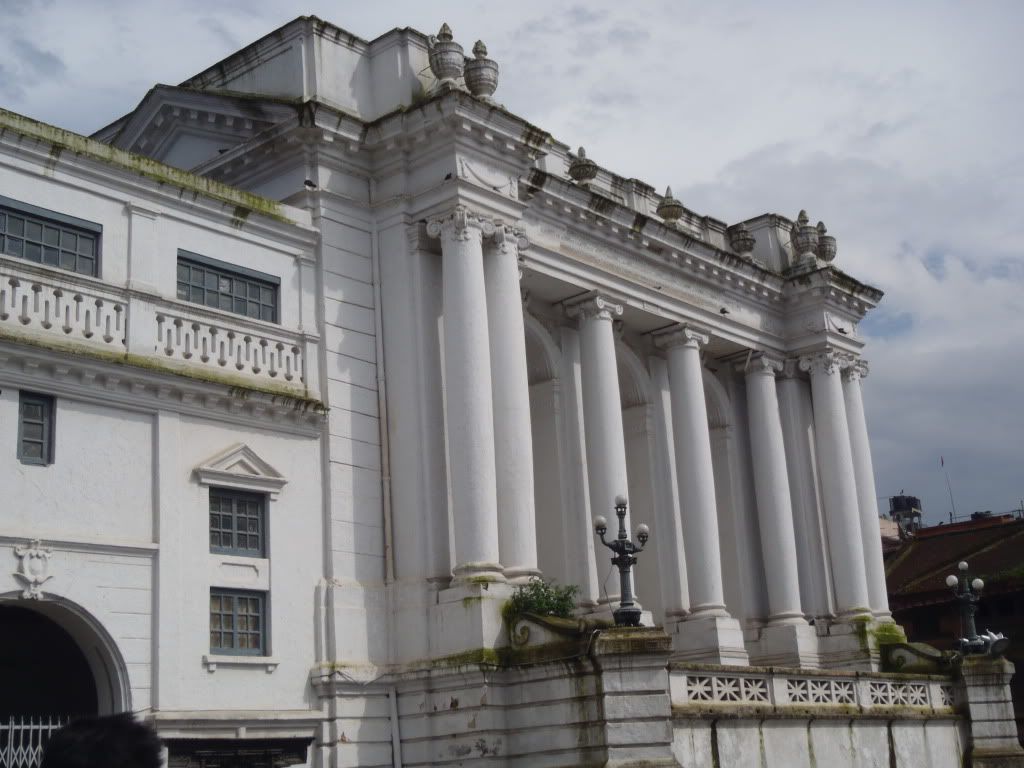
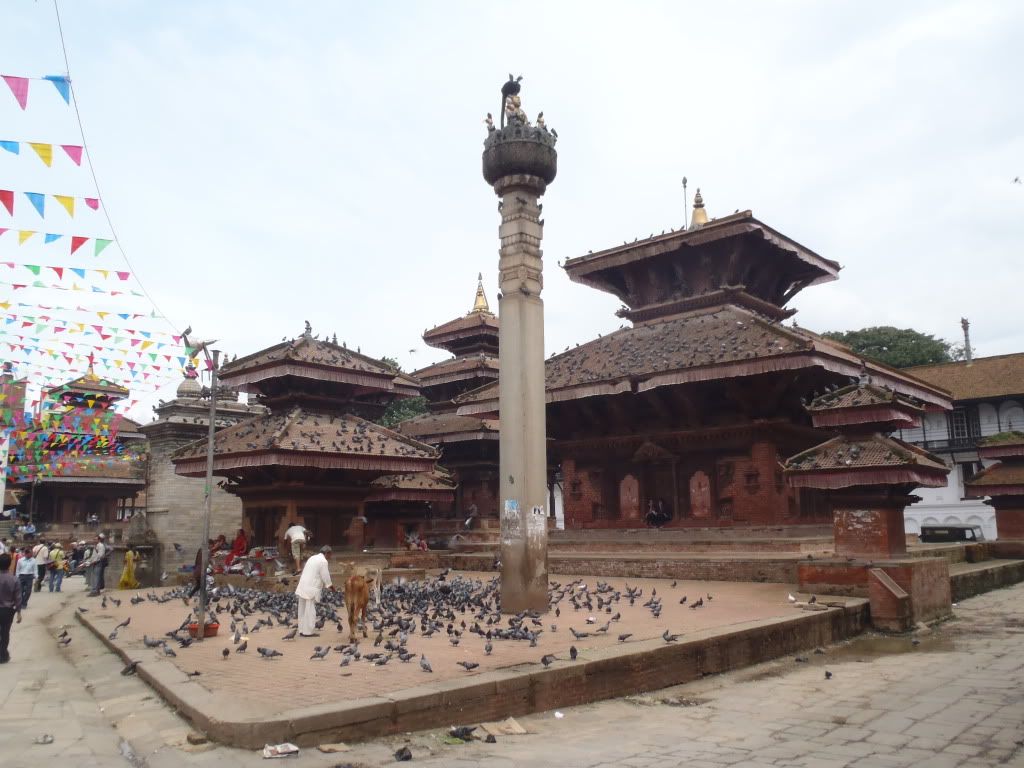

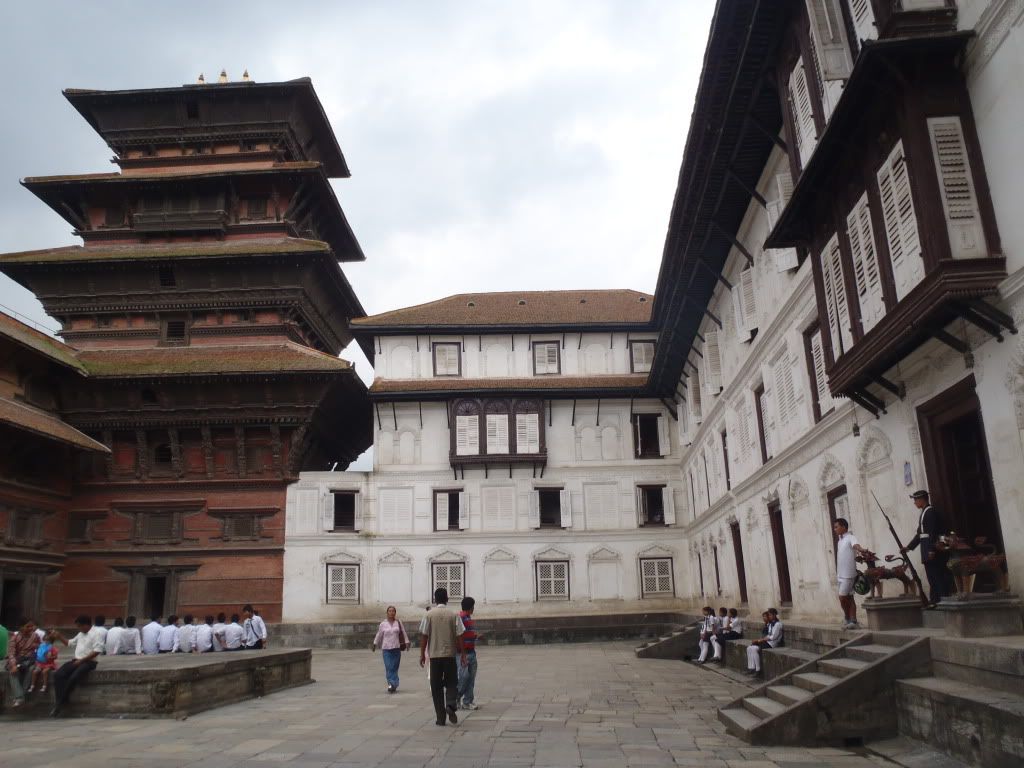
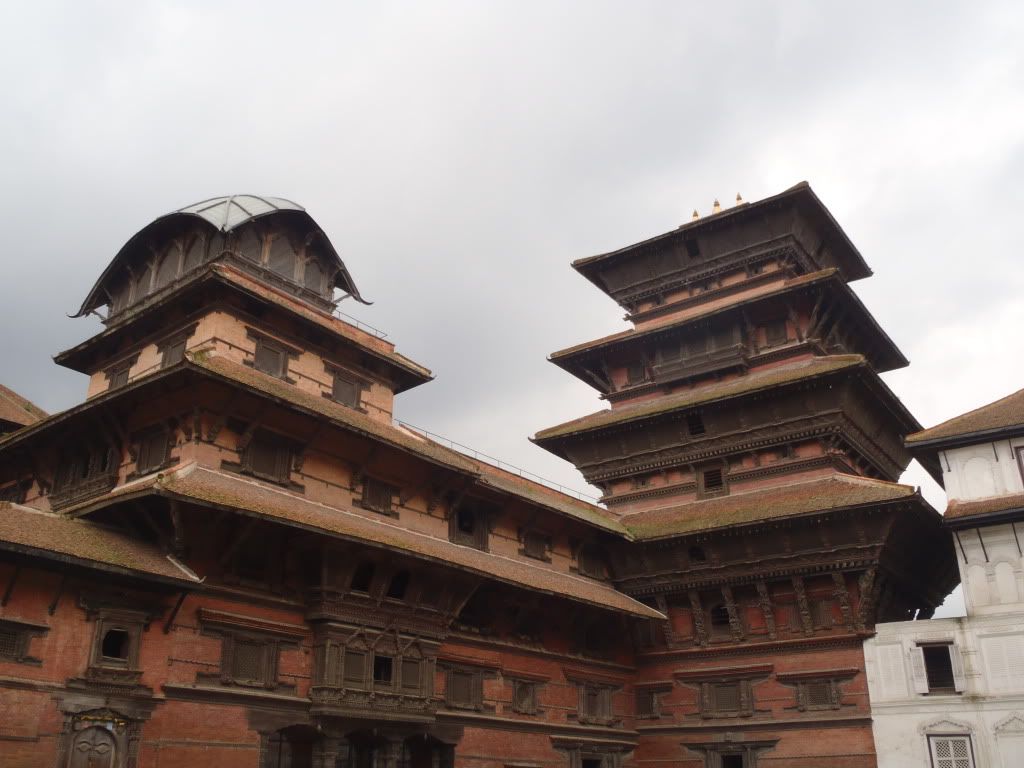

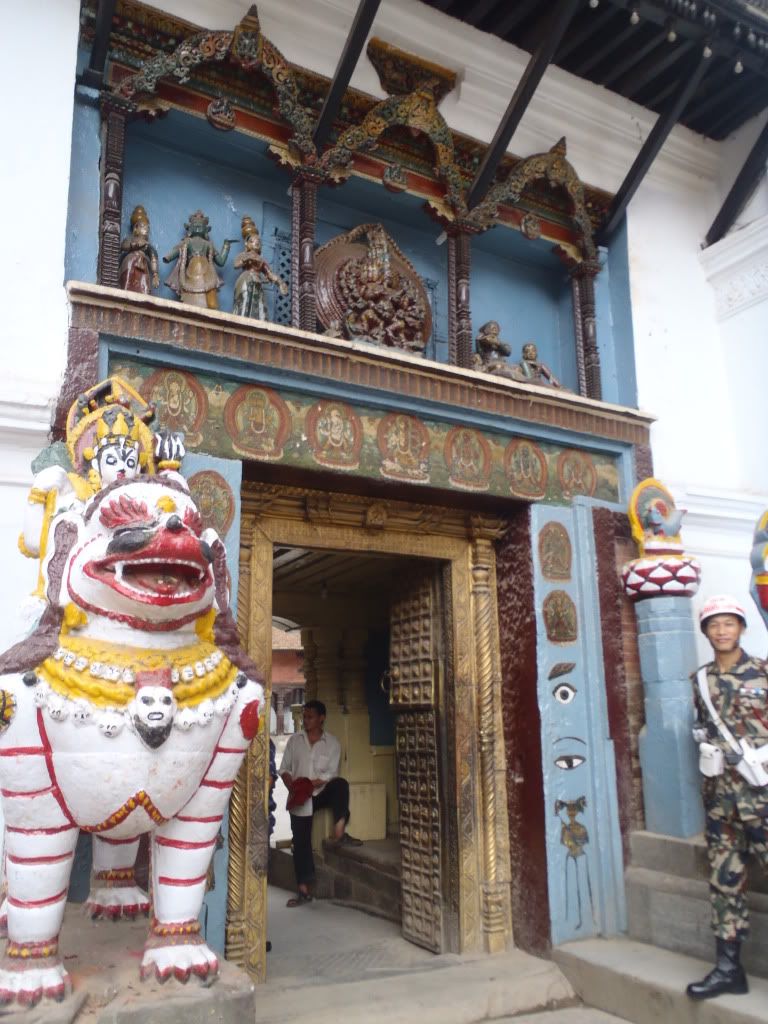
The Hanuman Dhoka is the former home of the Malla Kings – Nepal, previous to the Maoist government takeover, was a monarchy with royals ruling over the people. In fact it was H.M. King Tribhuvan Memorial Museum we entered first, a museum which paid tribute to the past and most recent royal rulers. The museum was filled with the royals’ personal belongings including their thrones, furniture, weapons, collections, etc. We walked through the museum and saw all of the King’s childhood effects and photos of him as a youngster. In fact, there were many photos of the King’s entire life – meeting with other royals, going on trips to various countries, hunting expeditions. We weren’t allowed to take any photos ourselves, so you’ll have to rely on words to get the gist of it. Here is some great information I found from Nepal’s tourism website about the King’s life, support of democracy, and the process of Nepal’s transition to democracy:
“The King of Nepal, King Tribhuvan, was born in Kathmandu on 30 June 1906. His mother was the regent, as he became king at the tender age of 5. Tribhuvan was officially crowned in the year 1913, but the Royal Family did not rule Nepal. The Rana family was in control of the country and they often made decisions that had a negative impact of the country. It is known that during World War I, the Rana prime minister literally held a gun to the head of King Tribhuvan’s mother in an effort to force him into supporting their war efforts. Blackmail was the only method the Rana’s could use to have the King agree to their requests.
Fortunately the public became increasingly unhappy with the Rana’s rule and they supported the return of the country’s power to the monarch. By the 1930’s the King was of age to rule Nepal. It was only due to the outbreak of World War II that the Rana’s spared the kings’ life. They did this on the request of the British who wanted Nepal backing them in the war. But after the war ended and Britain moved out of India, the King and his family fled to India to escape the wrath of the disposed Rana family. Through pressure from the public and from international countries, the Rana’s were forced to admit defeat and conform to the kings’ dream of democracy. King Tribhuvan took charge of the country’s transition until his untimely death due to illness in 1955.”
One of the most interesting (and tragic) stories we heard in the museum about Nepalese royals occurred very recently, in 2001. Dipendra Shah, son of the then-current King of Nepal grew extremely angry at his mother for denying him the right to marry his girlfriend, a Rana girl. Traditionally the Shah had been intermarrying with the Rana clan but the two families never had any love for one another and his mother didn’t want him to marry a Rana girl. One night, Dipendra got drunk and went on a rampage, massacring his entire family – father, mother, brother, sister – before killing himself as well.
Once we went outside the palace, we spotted the Jagganath Temple, probably built by King Malla, and definitely one of the oldest buildings in Durbar Square. The temple is famous for its wooden erotic roof carvings. Basically, nothing is left to the imagination! Equivalent of ancient-times ‘soft porn,’ these carvings helped locals figure out what to do sexually with others serving as a ‘how to’ guide of sorts. When we walked further to the right, Henk and I spotted the infamous stone inscription we had read about previously. The story goes that if someone deciphers all of the different 15 languages on the inscribed wall, milk should flow from the spout in the center. Since Henk has an interest in languages, I wanted him to try and decipher the code but there were quite a few ancient/archaic ones on there that even locals would have no idea about! We later heard that there are 53 different languages in Nepal alone, and that's not including those language mixes that have gone ‘out of style’ over the years. Some languages only have a few people left who can decipher them, which is probably very dangerous for the preservation of Nepal’s heritage.
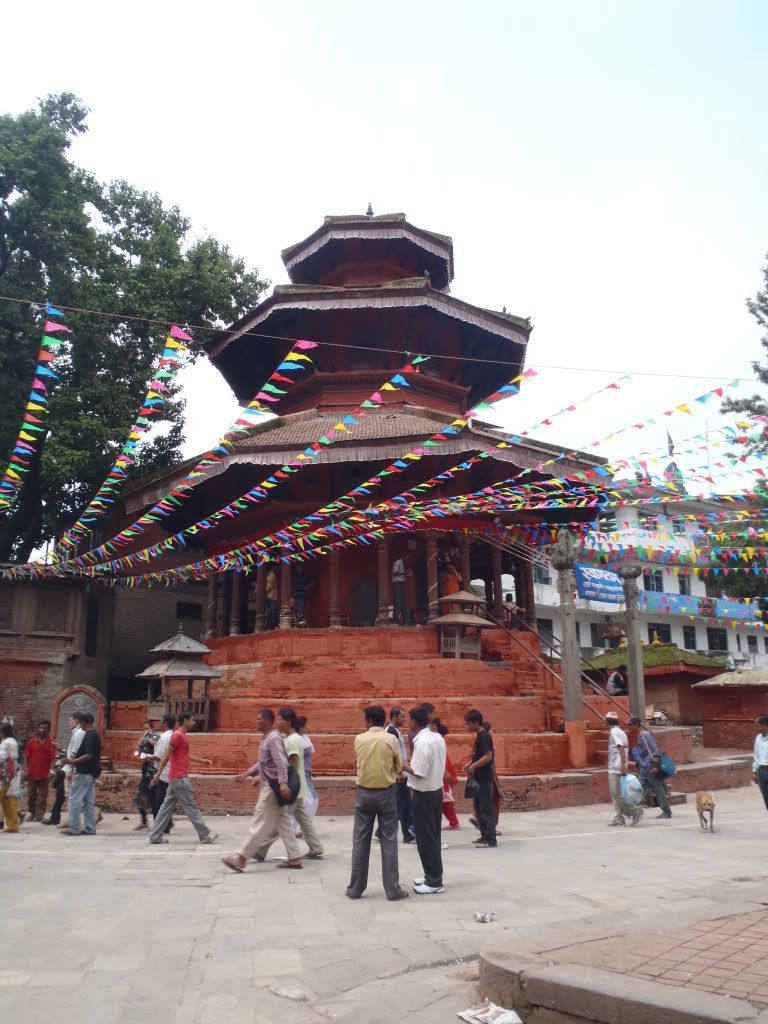
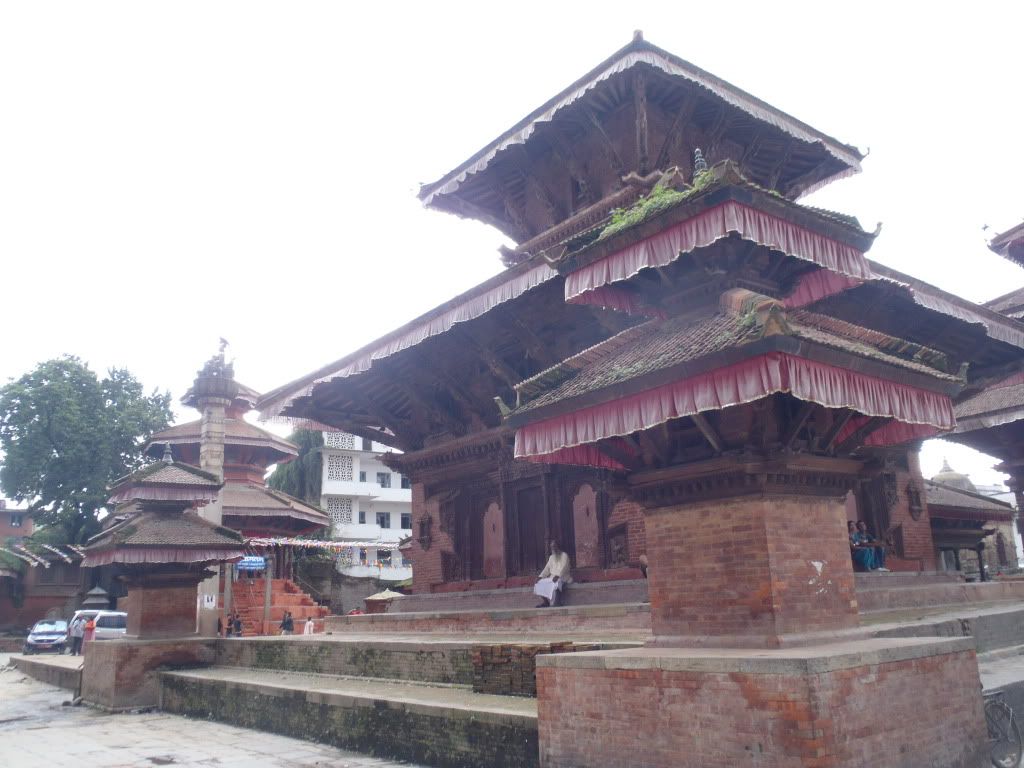
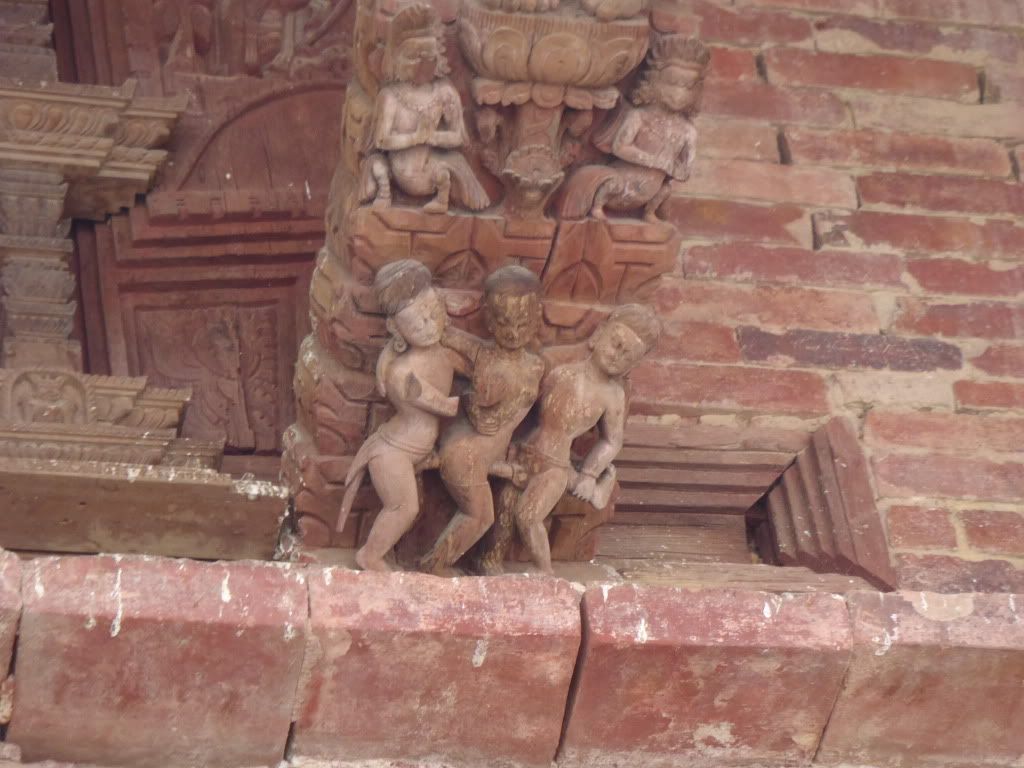


The next thing that caught our eyes was the white-roof (now slightly green-roofed due to mold and aging) on the Kakeshwar Temple – a temple with a bit of mixed architectural styles such as the Newari-style floor and the Indian-style upper storey. That must be why it looks a little out-of-place in the square! The Taleju Temple (built in 1564 by King Mahendra Malla) was next on our list, and it impressed us with its decorative gate with guarding lions out front. The various symbols, eyes and Hindu figures, reminded me of a secret organization in the way it is presented. The temple itself was built in honor of a goddess named Taleju Bhawani who became popularized as the goddess of the Malla Kings.
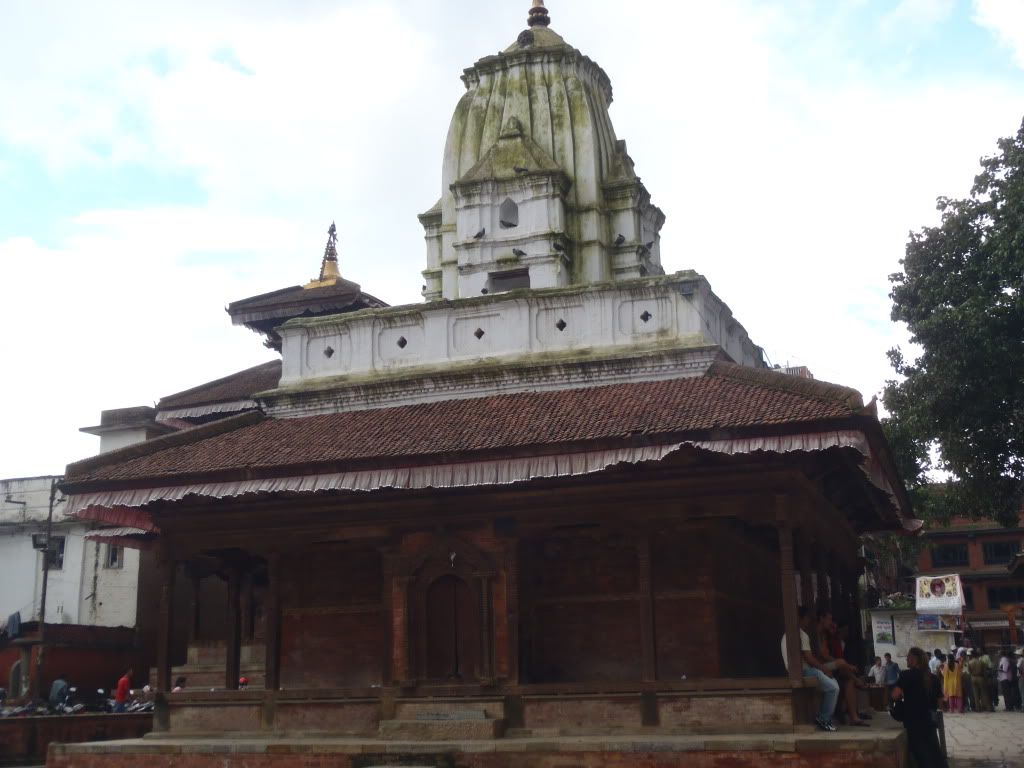
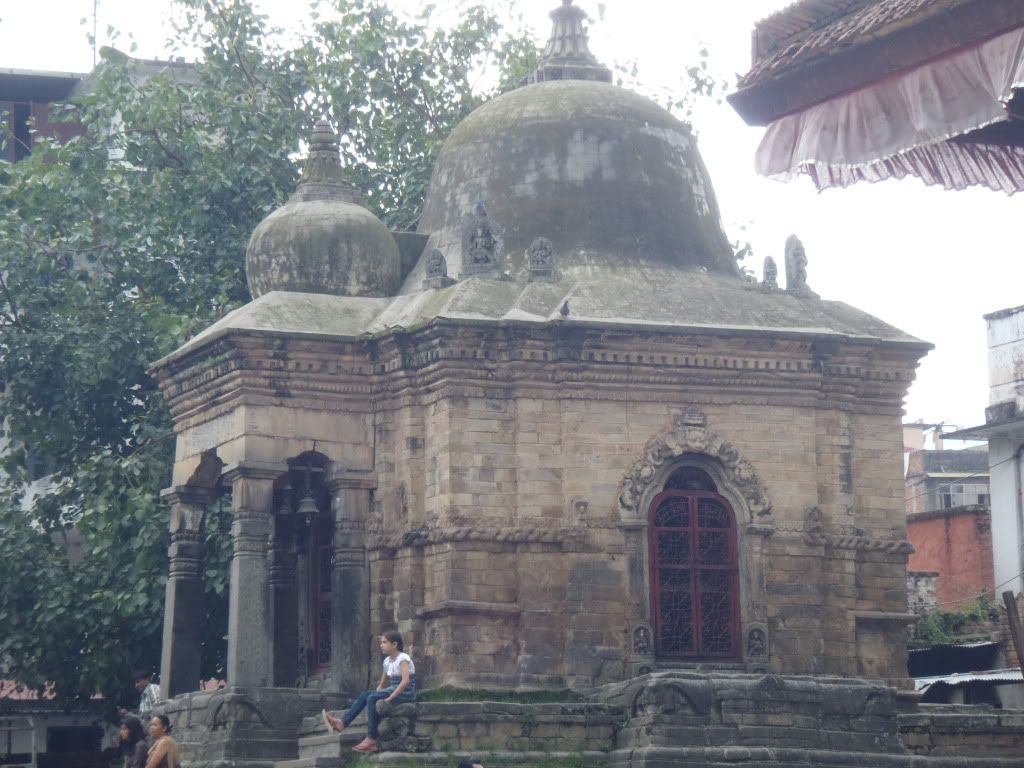
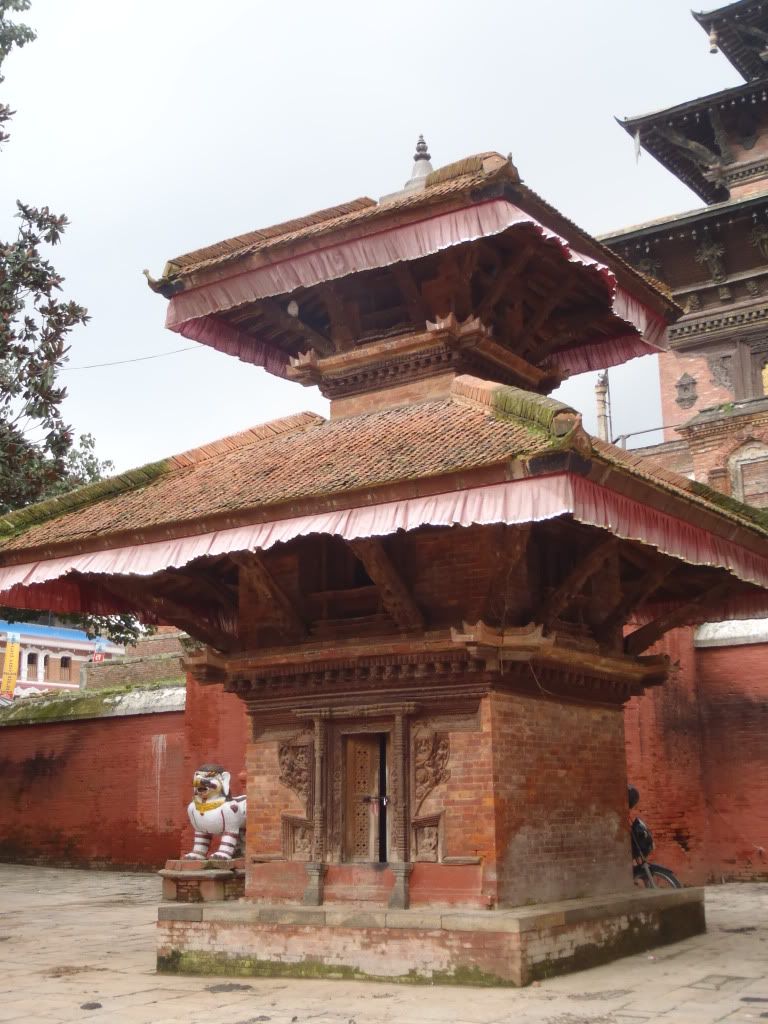
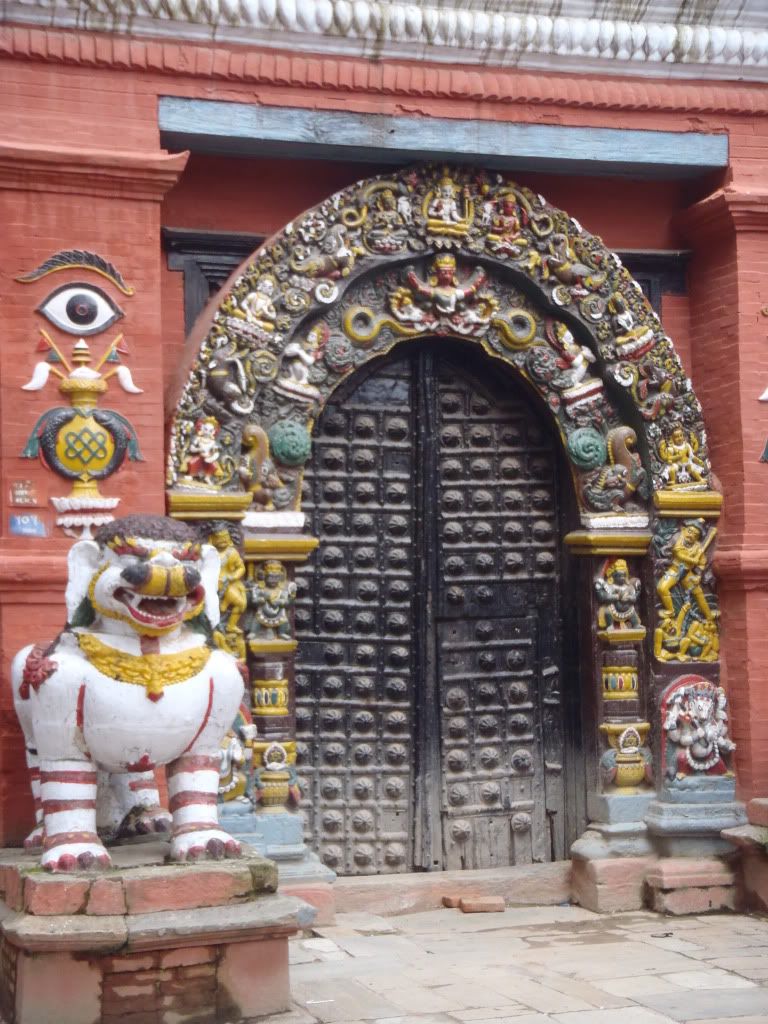
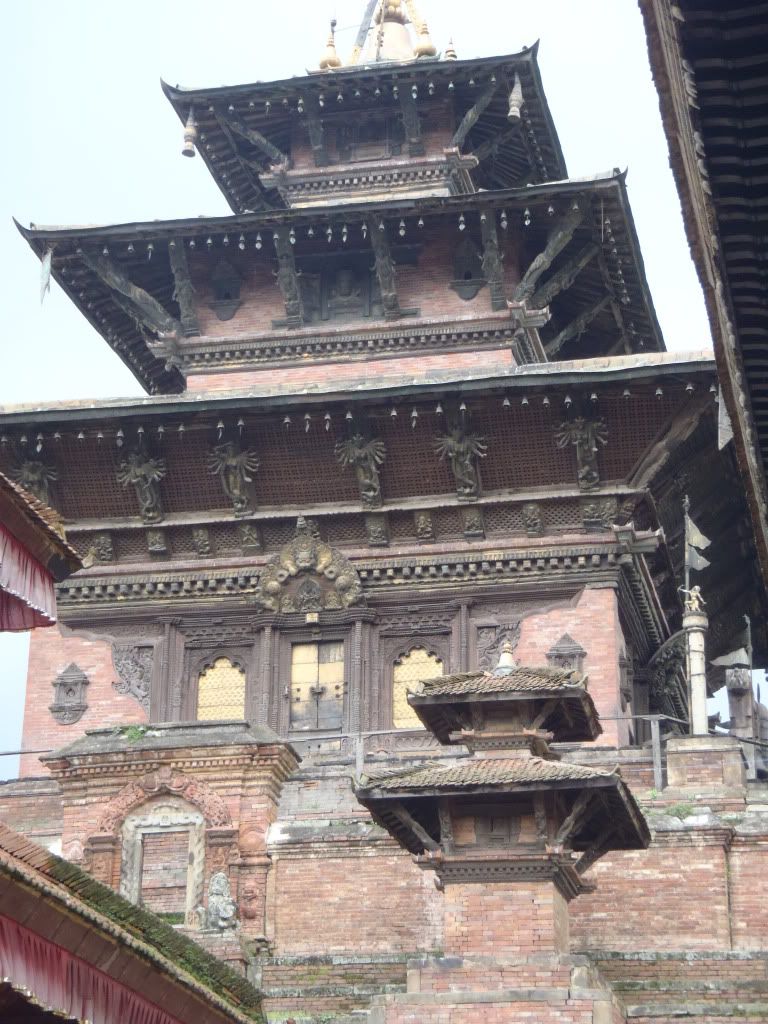
We couldn’t go into the temple itself, much less past the imposing gates, so we moved on to the opposite end of the square to peek at the Mahendreshwar (Shiva) Temple. One thing to notice about this temple is the long ‘ladder’ or ‘chain’ of what looks like gold-colored plates hanging together from the top of the temple leading to the bottom. While the exact purpose of these plates doesn’t seem to be 100% certain, I heard that they are there for the gods to use in case they need to come down to earth (say as an incarnation, etc.) to complete ‘divine business.’ This temple had one of the best examples of such ladders, so take a look! It started to rain quite hard at this point, so we ducked into the Tana Deval Temple which had skulls and seemingly hideous faces adoring its walls. The feeling of the creepy-yet-cartoony characters reminded me of Halloween!
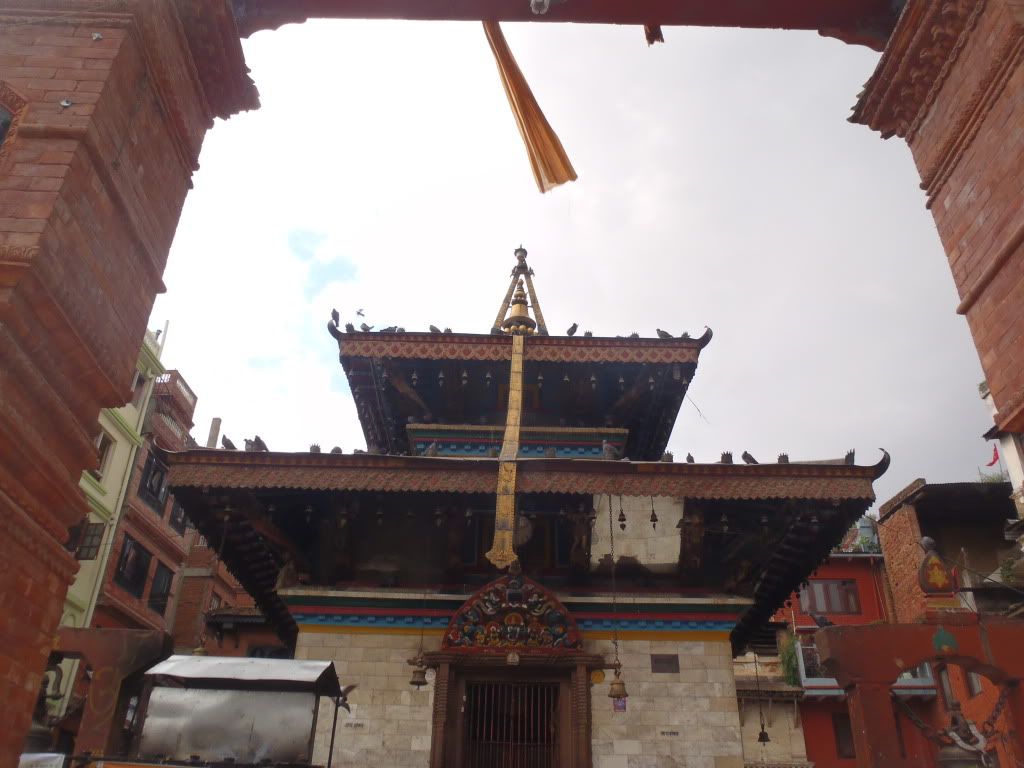
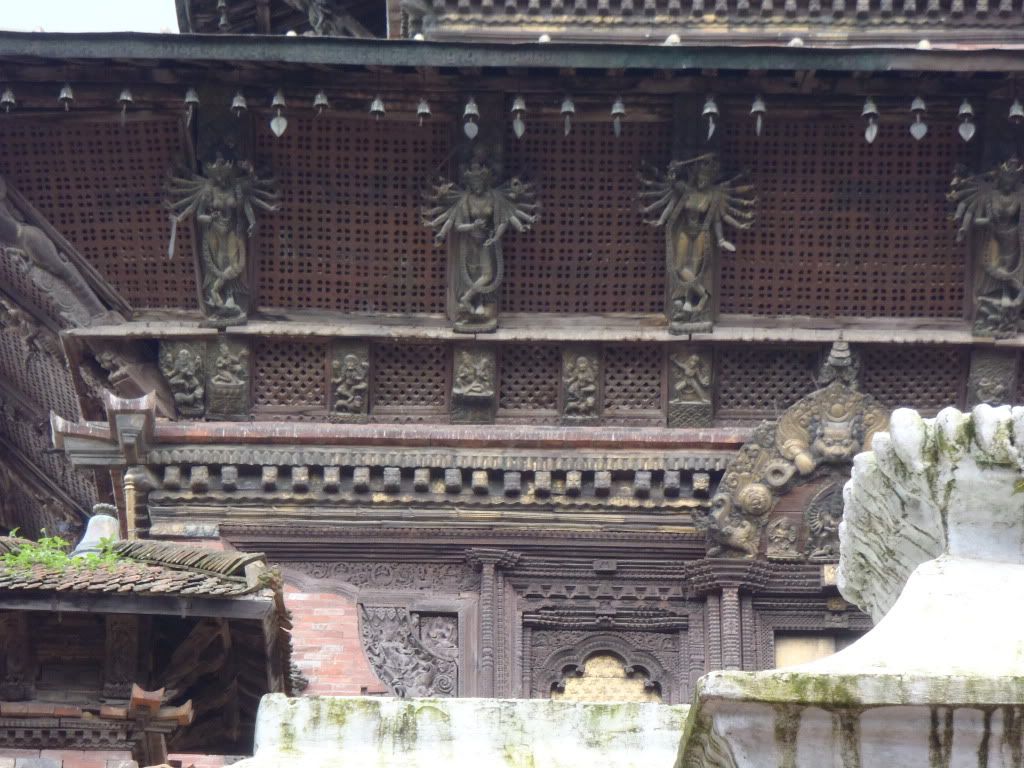
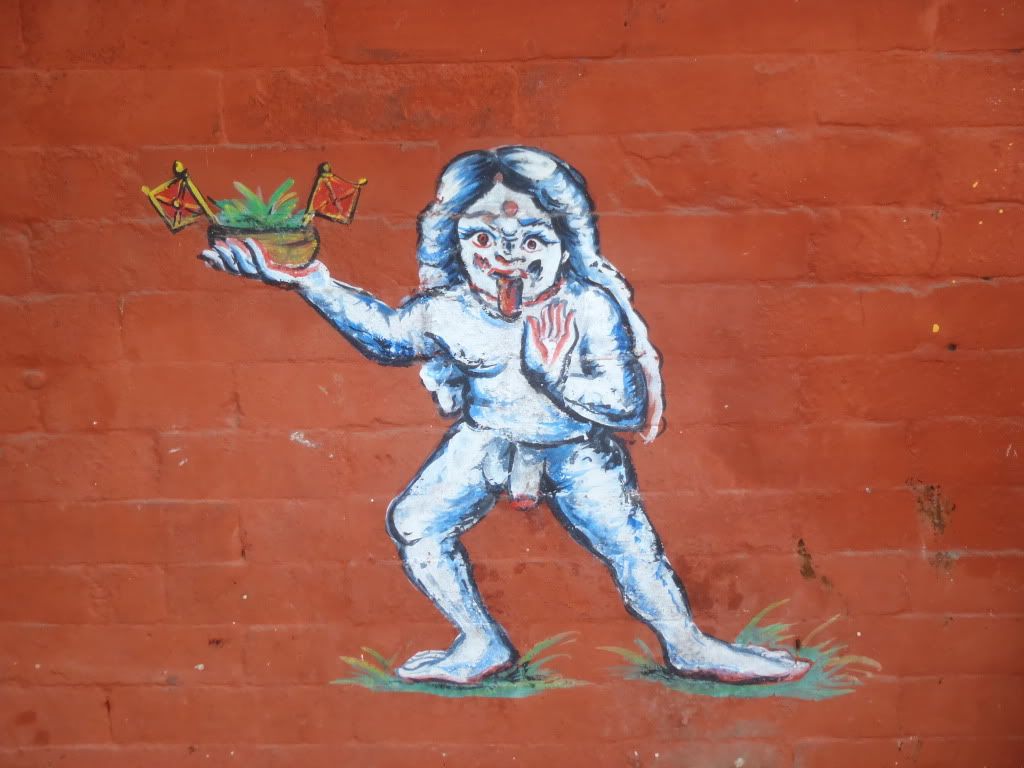
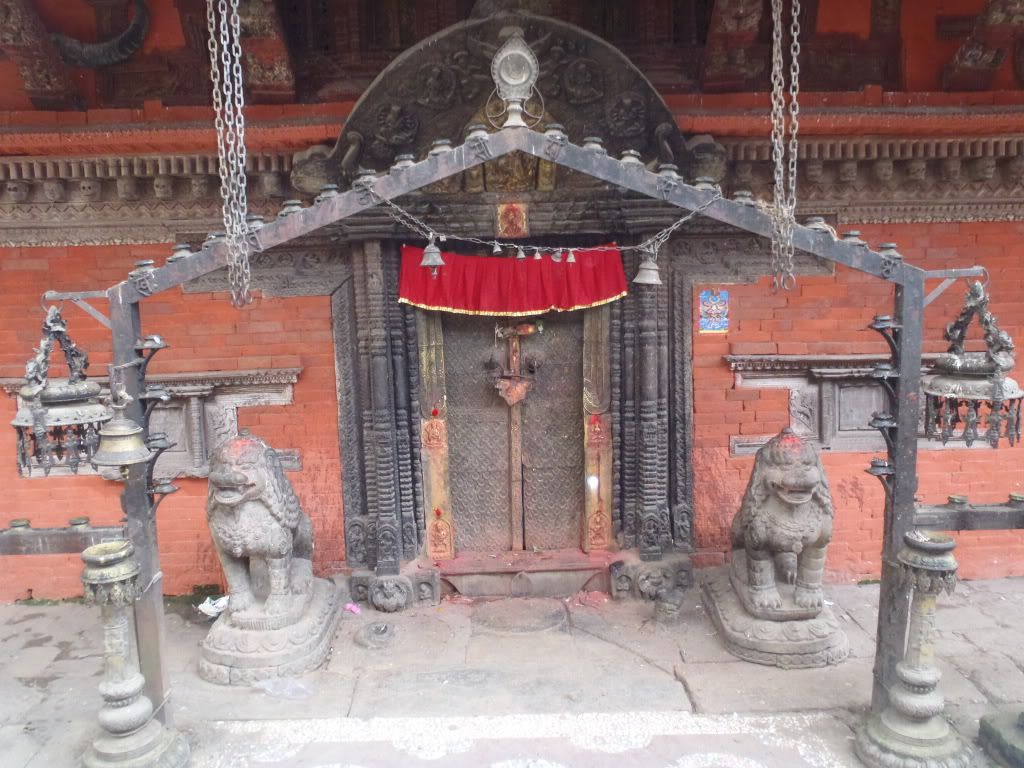
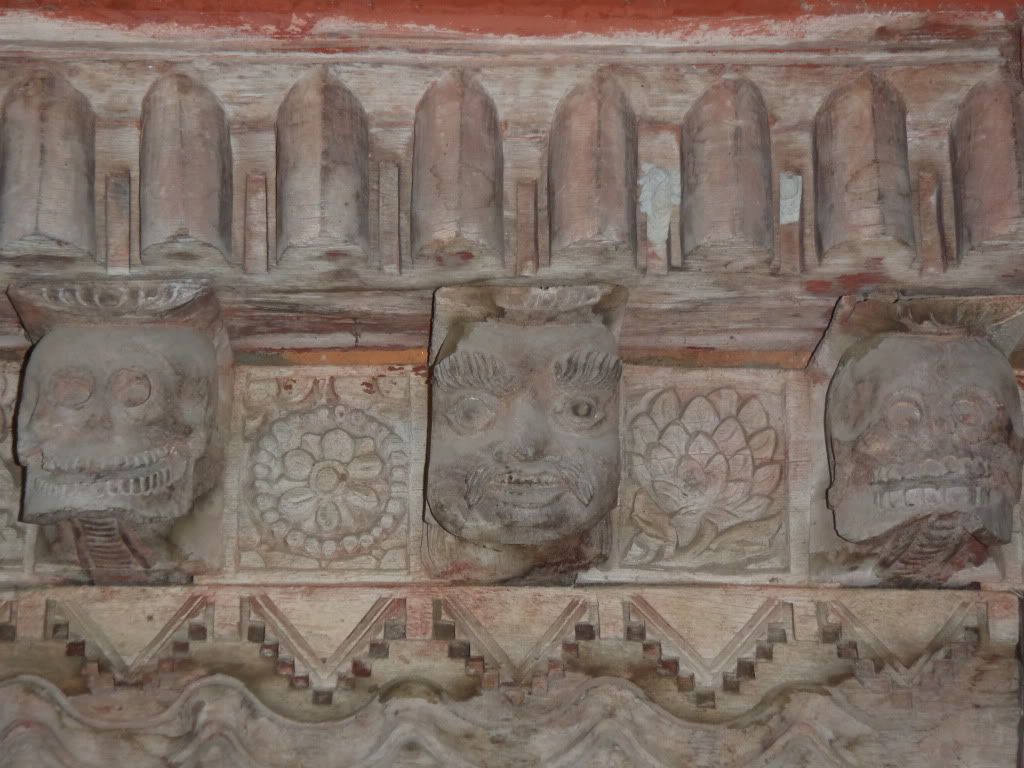
Once the rain let up a little we walked down Makhan Tole which was supposed to be one of the more interesting streets to check out in Kathmandu. Perhaps it was due to the rain, but the street didn’t seem too special to us. We passed a few smaller temples before stopping in awe in front of the large, colorfully decorated carving of one of Shiva’s manifestations -- Kala (Black) Bhairab – who tramples a corpse representing human ignorance. This demonic-looking deity’s origin is best told in the following tale I read on a religions and gods blog:
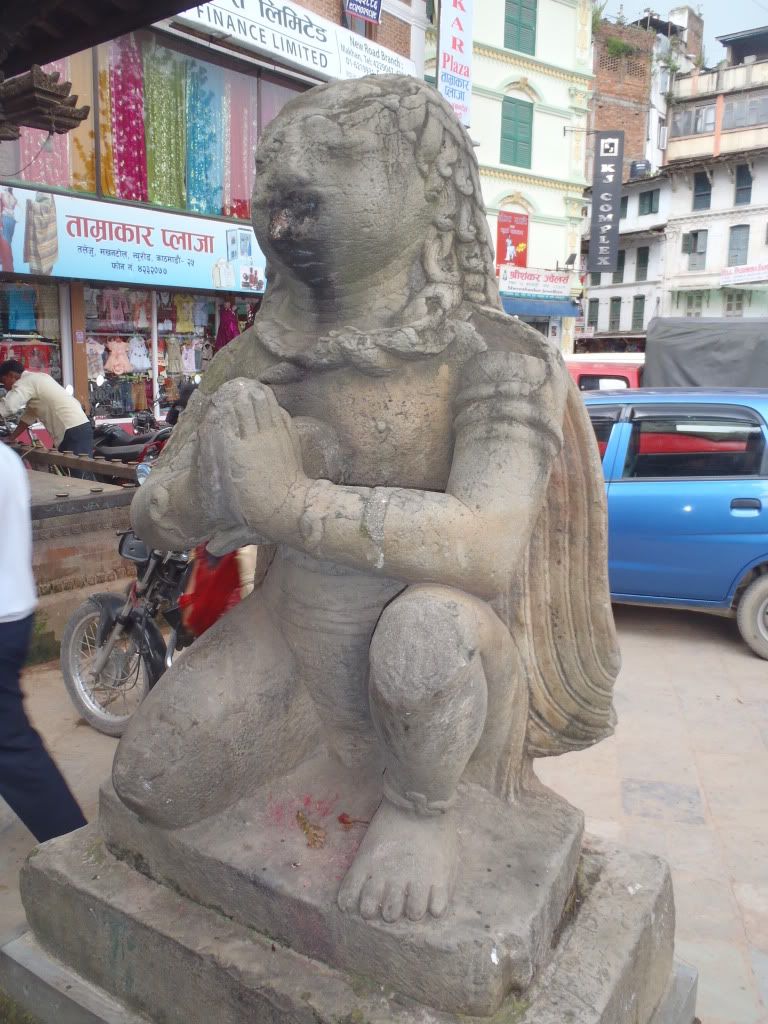
“The origin of Bhairava can be traced to the conversation between Lord Bramha and Lord Vishnu recounted in "Shiv Maha-Purana" where Lord Vishnu asks Lord Bramha who is the supreme creator of the Universe. Arrogantly, Bramha tells Vishnu to worship him because he (Bramha) is the supreme creator. This angered Shiva who in reality is the creator of all. Shiva then incarnated in the form of Bhairava to punish Bramha. Bhairava beheaded one of Bramha's five heads and since then Bramha has only four heads. When depicted as Kala Bhairava, Bhairava is shown carrying the amputated head of Brahma. Cutting off Brahma's fifth head made him guilty of Brahmanicide, and as a result, he was forced to carry around the head for years until he had been absolved of the sin.”
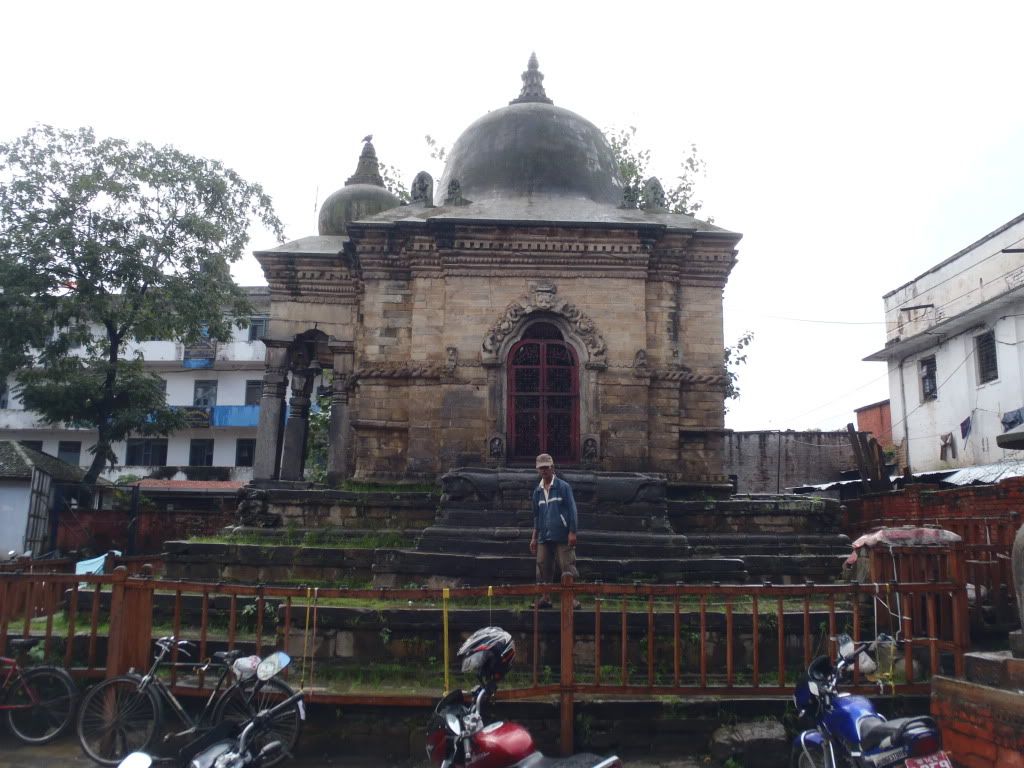
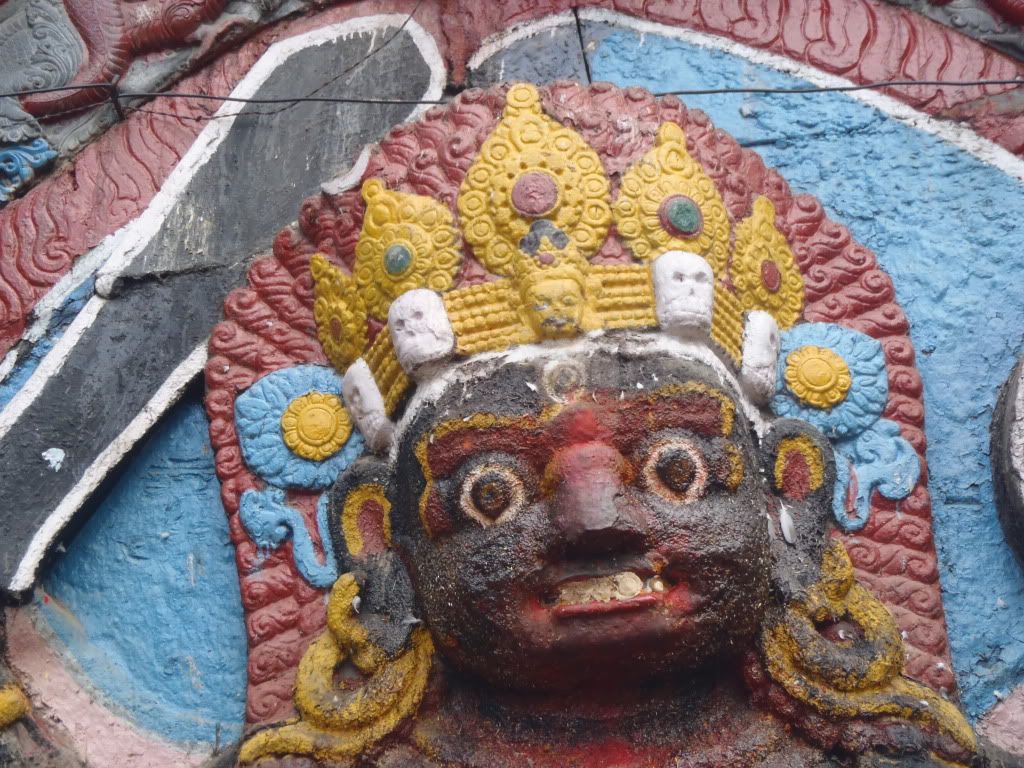
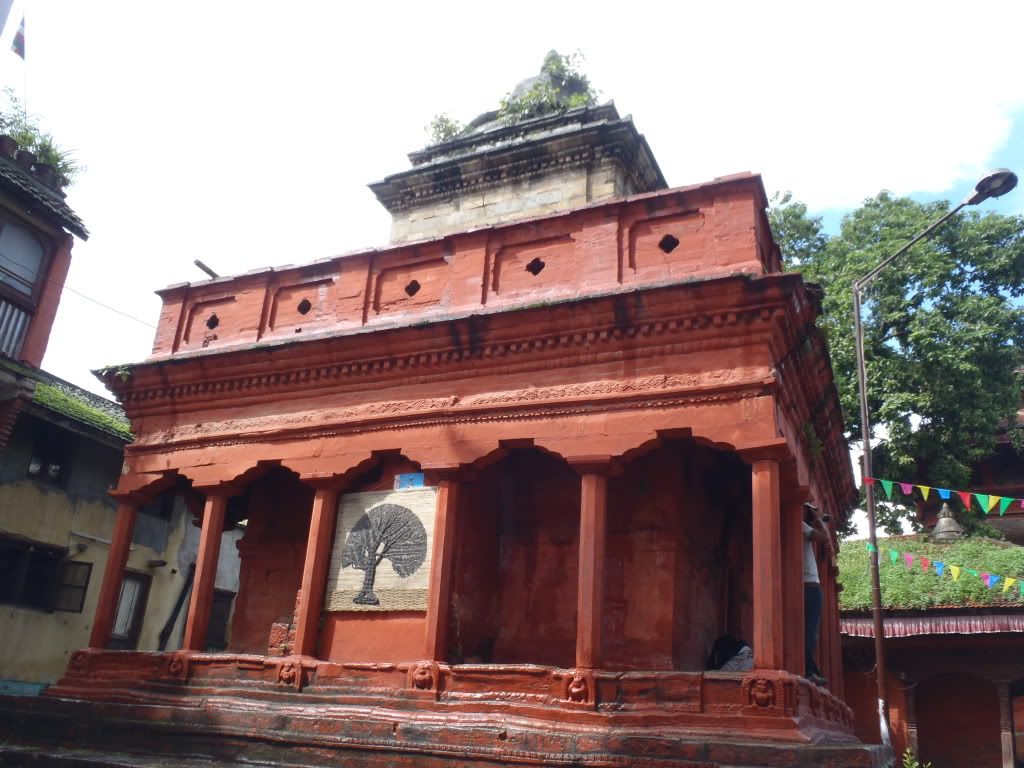
Next we found an old Shiva-Paravati Temple with a special twist. If you look at the top window, you can see the figures of Shiva and Paravati looking out at the square below. Not much to say about this one, just interesting to look at it! After passing an effortless yet striking statue of the half-man/half-bird Garuda, we finally found it. Was was it?
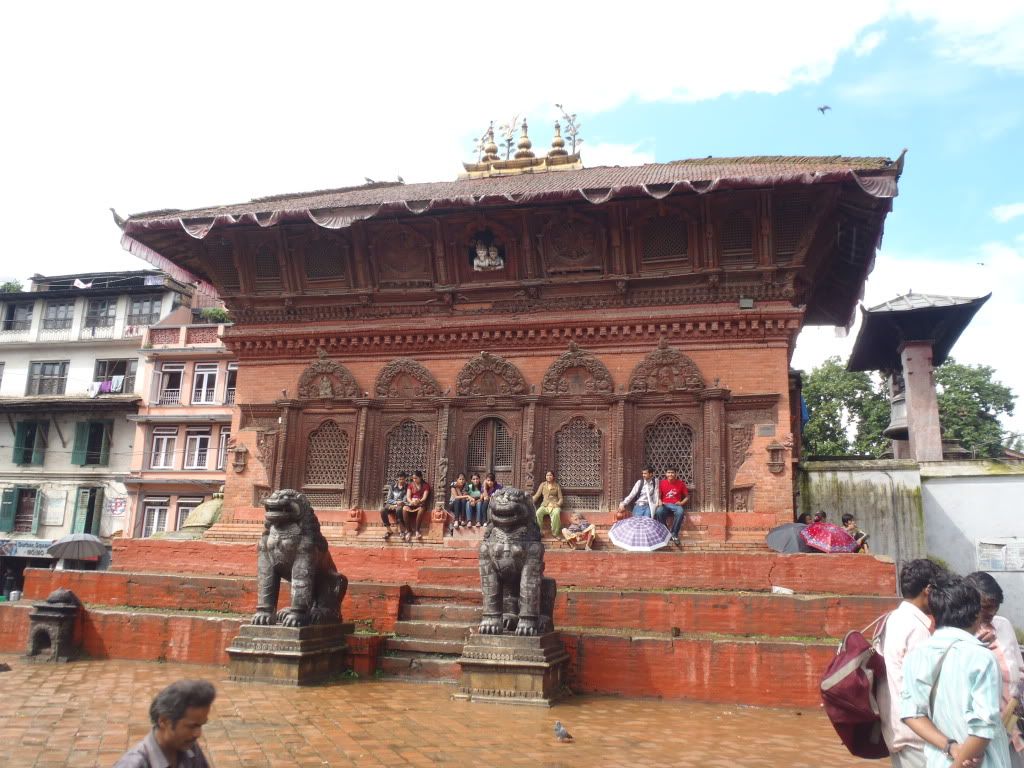
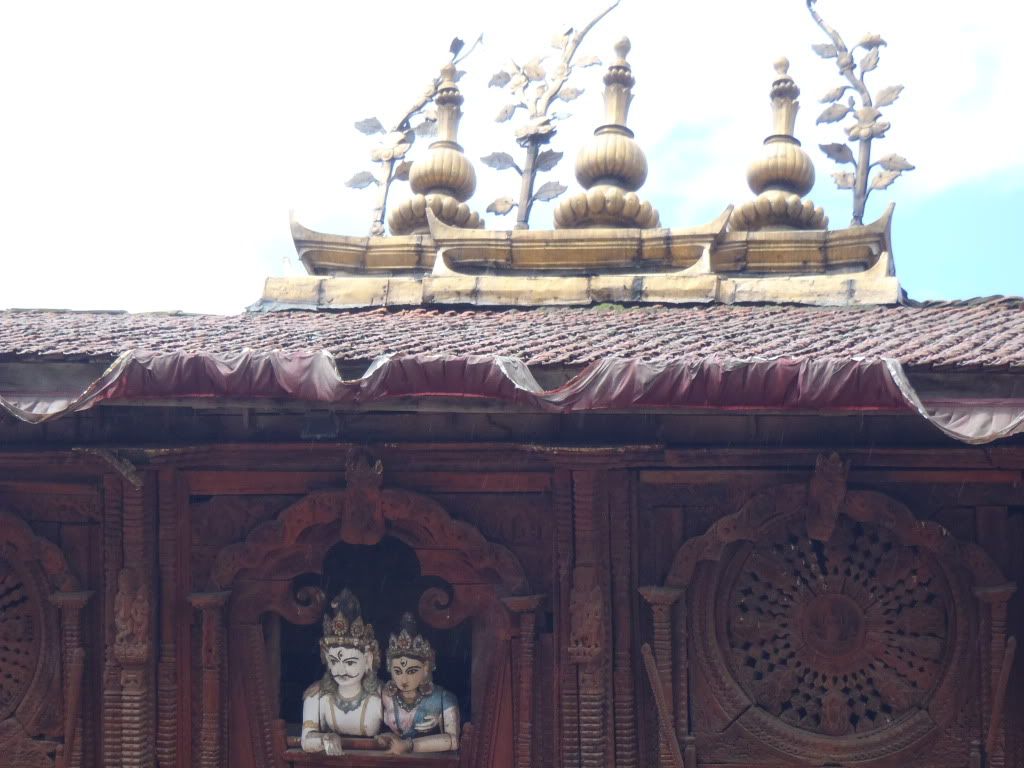
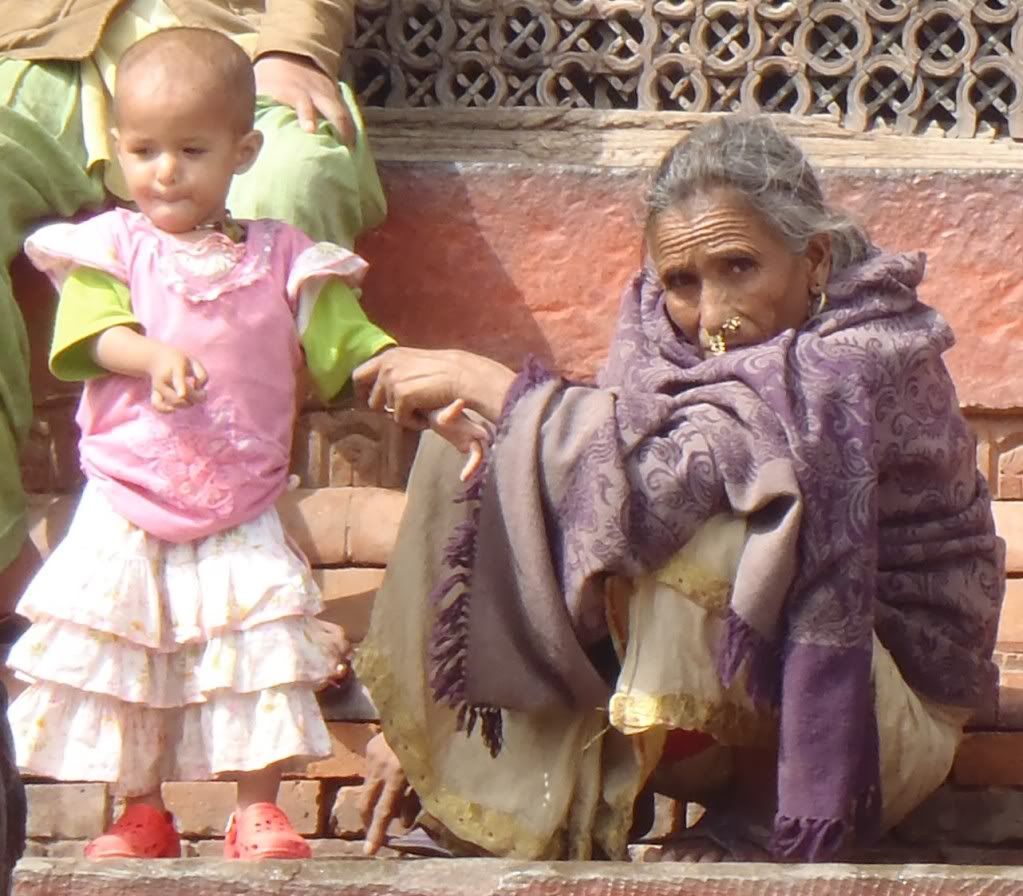
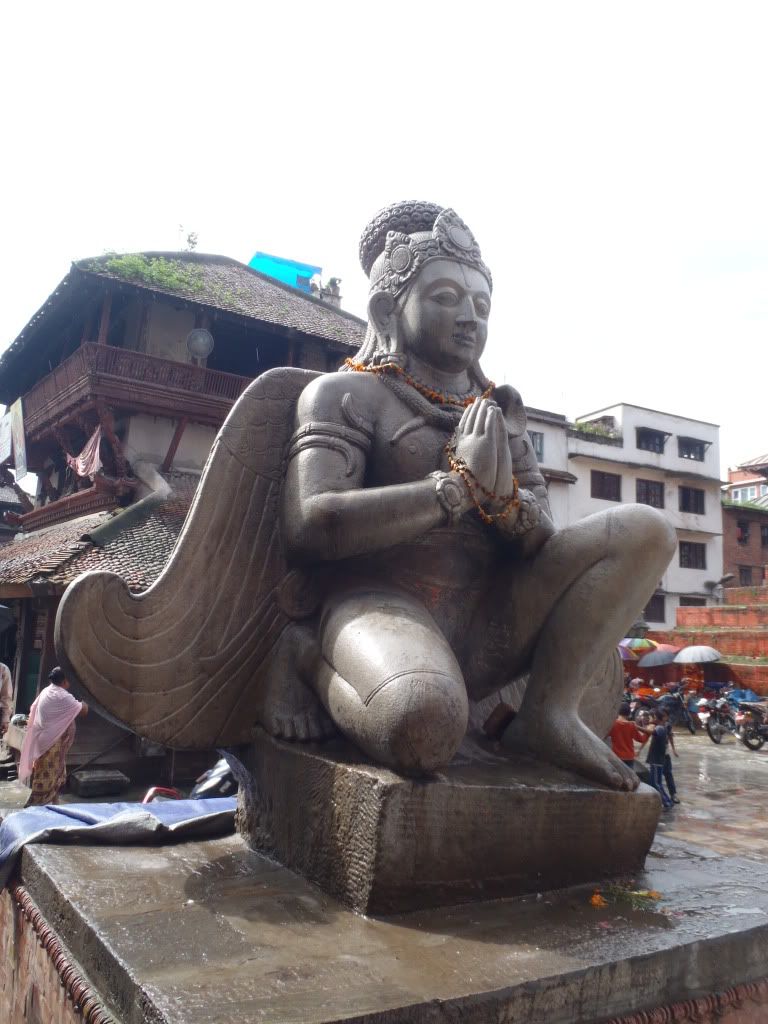
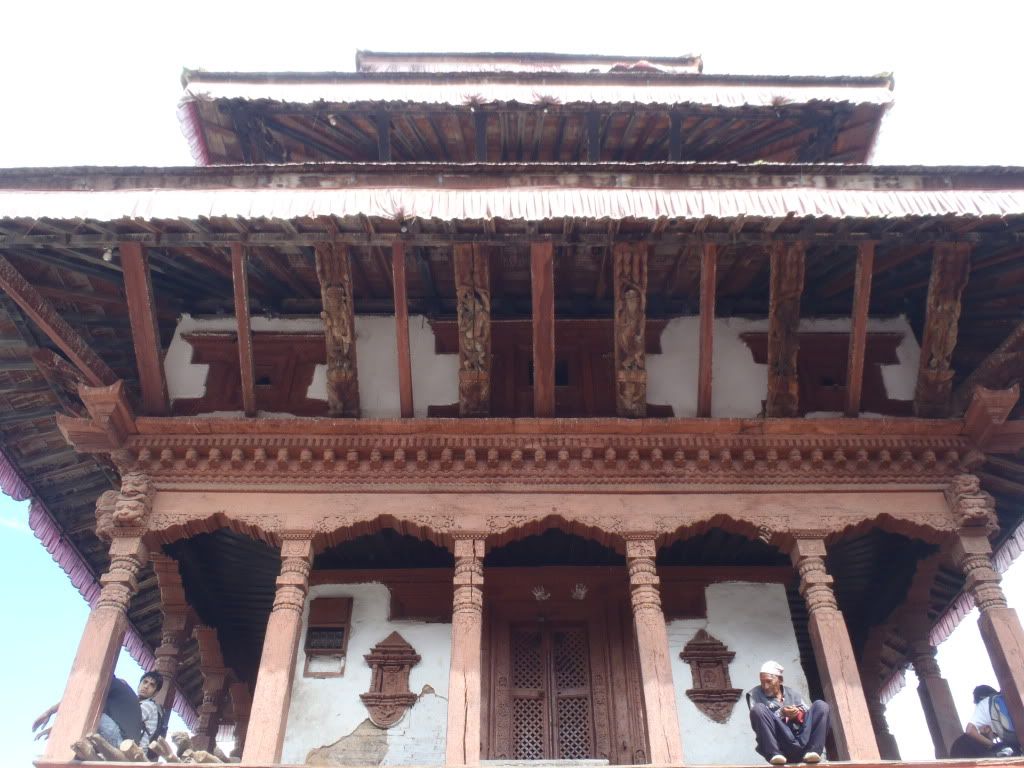
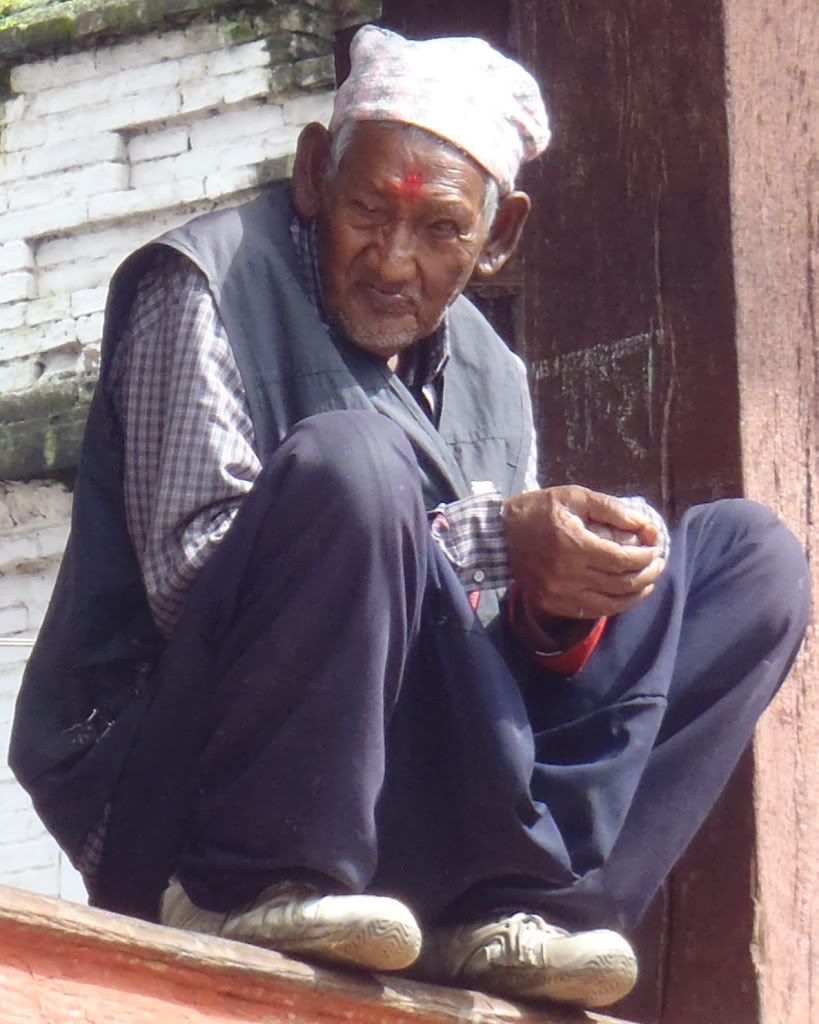
IT was one of the most fascinating buildings: the home of the living goddess Kumari. The Kumari Bahal was built in 1757 and has three stories with carved wooden windows and a courtyard in the center. Henk and I explored the courtyard of the Kumari’s house, knowing that we would see her later that month at the Indra Jatra festival. The building is still used to house her and her caretakers, visitors can enter the courtyard but the Kumari is only allowed to go into public during the Indra Jatra festival or other ceremonies. The living goddess is only worshipped as a living version of the divine Taleju (the goddess of creative feminine force) from the time she is chosen until she has her first period (or loses a lot of blood some other way) and ‘becomes mortal’ again as Taleju leaves her body. From the Wiki page on the Kumari, I learned the origin of the living goddess:

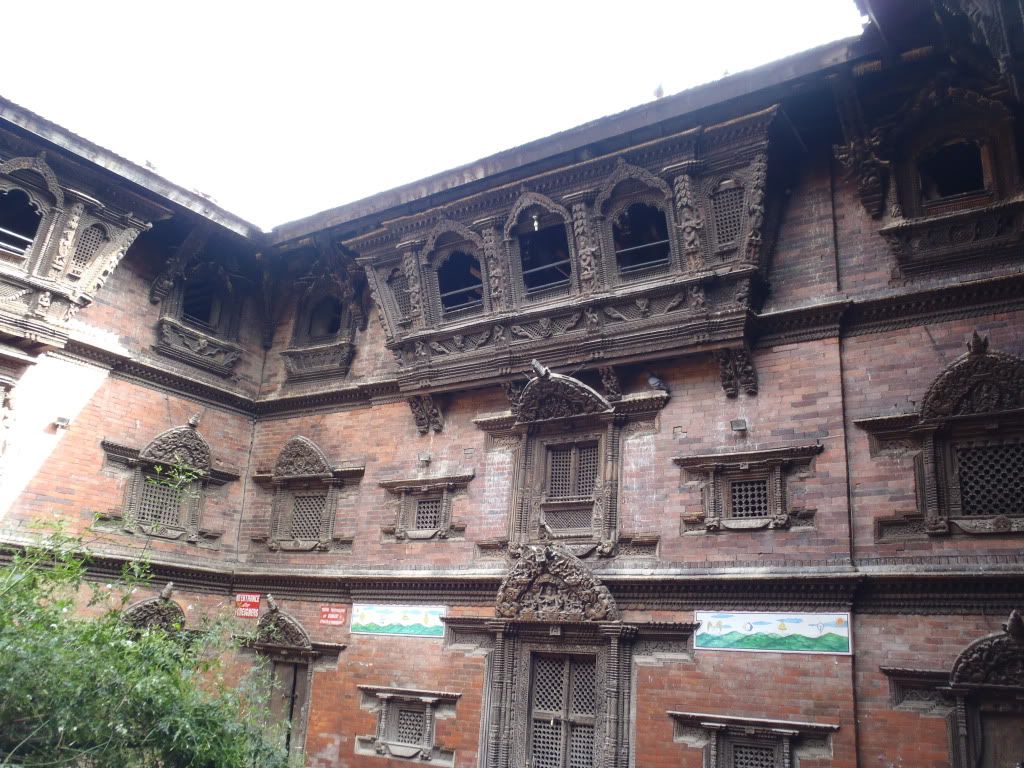
“There are several legends telling of how the current tradition of the Kumari began. Most of the legends, however, tell of King Jayaprakash Malla, the last Nepalese king of the Malla Dynasty (12th-17th century CE). According to the most popular legend, a red serpent approached the king's chambers late one night as he played tripasa, a dice game, with the goddess Taleju. The goddess came along every night to play the game, with the condition that the king refrain from telling anyone about their meetings.
But one night the king's wife followed him to his chamber in order to find out who the king was meeting so often. The king's wife saw Taleju and the goddess was angered. She told the king that, if he wants to see her again or have her protect his country, he'd have to search for her among the Newari (Shakya) community, as she would be incarnated as a little girl among them. Hoping to make amends with his patroness, King Jayaprakash Malla left the palace in search of the young girl who was possessed by Taleju's spirit.”
Once a potential Kumari is found, she is tested is various ways. Since the Kumari is the living Taleju, she is supposed to be fearless. This is tested by bringing placing potentials in front of bloody animal heads to see if they get scared – even having the children spent a night in a room filled with animal heads. (The real Kumari would obviously show no fear.) The Kumari’s looks must be feminine and ‘dainty’ and she must have black eyes and hair. A few of the other psychical requirements (via Wiki) are:
• A neck like a conch shell
• A body like a banyan tree
• Eyelashes like a cow
• Thighs like a deer
• Chest like a lion
• Voice soft and clear as a duck's
Finally, the Kumari must pick out the possessions of the former Kumari, much like the potential Lamas must do in the search for the new Dalai Lama. Once all of these tests are completed, there is one little girl left who becomes the Kumari and moves into the Kumari Bahal. By now it was just past 3:00 PM and we were getting hungry for something to snack on. A quick look through our Lonely Planet had us heading towards ‘Freak Street’ – a street near Durbar Square that used to be known for its, well, freaks. It was here that we found Snowman Cafe, a cake shop with amazingly delicious cakes. We opted for two slices, one chocolate and one apple. While the eatery looked really sketchy at first, the cake did impress and we left with full stomachs.
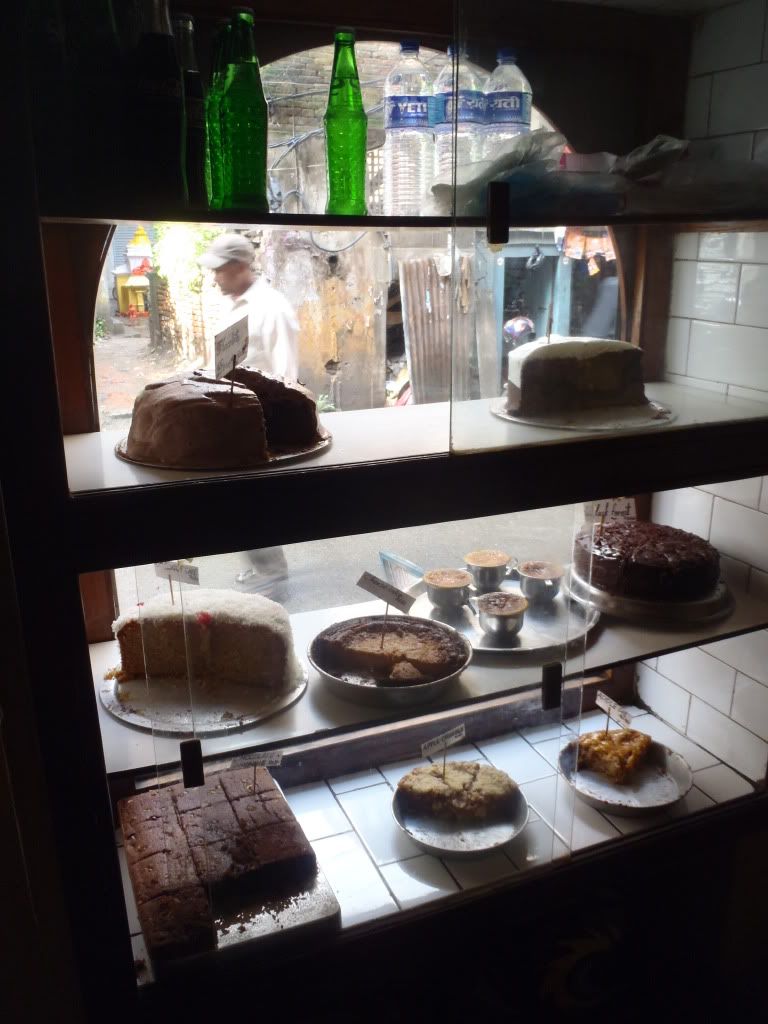
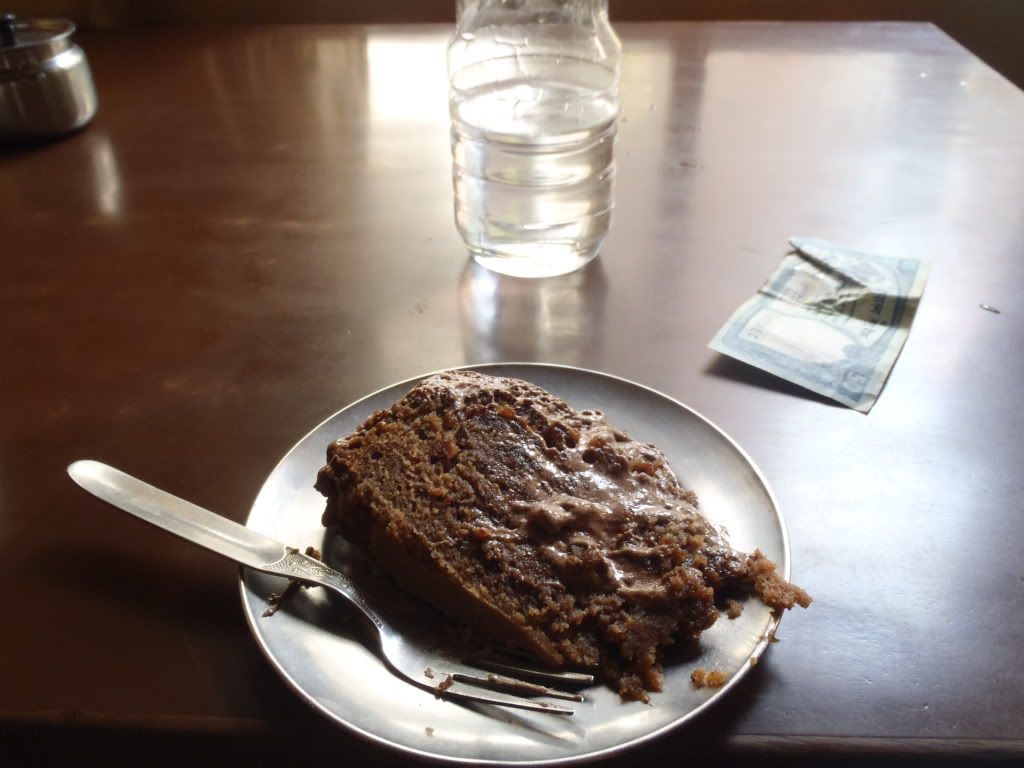
Returning to Durbar Square, we did a couple more hours of sightseeing. Since we have already discussed the bulk of Durbar Square, I’ll just summarize the last few buildings we saw: Kasthamandap is a large, three-roofed wooden building with decorative windows that was once a community center, but now is the remainder of a temple dedicated to the ascetic Goraknath. We saw a meeting of some kind going on inside while we were there, but it didn’t look very religious in nature, so maybe the building is a community center again. Next we saw a small Shikara-style (or Indian-style) stupa, and later the Trailokya Mohan Narayan Temple which was built in 1680 and dedicated to Vishnu.
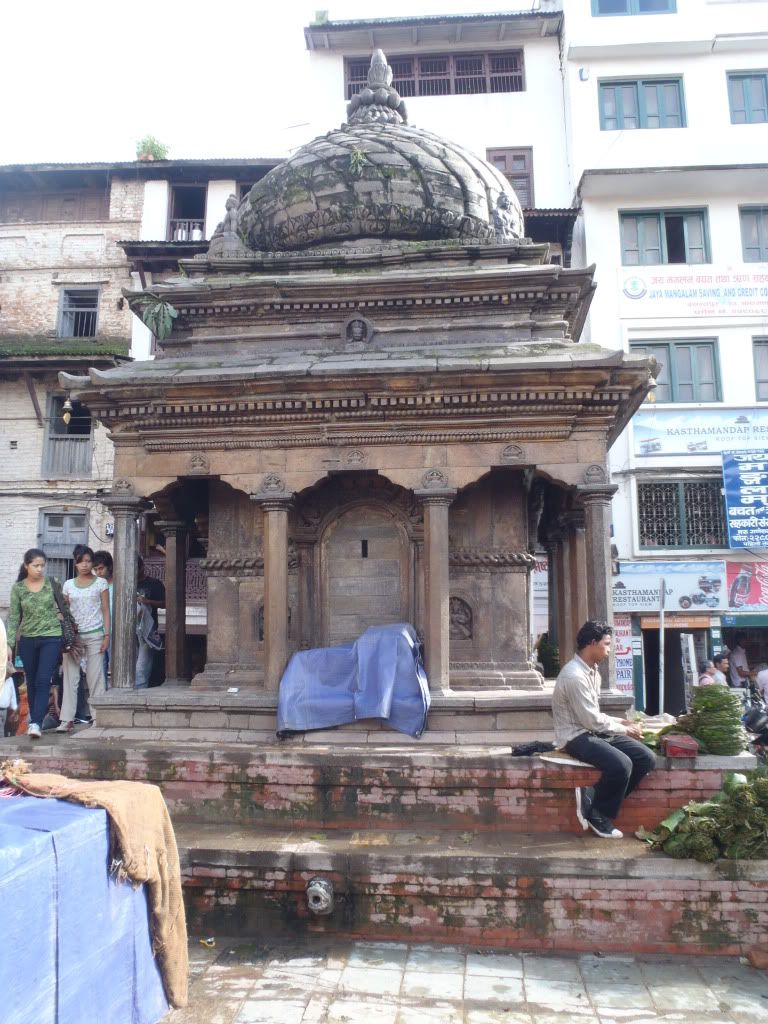
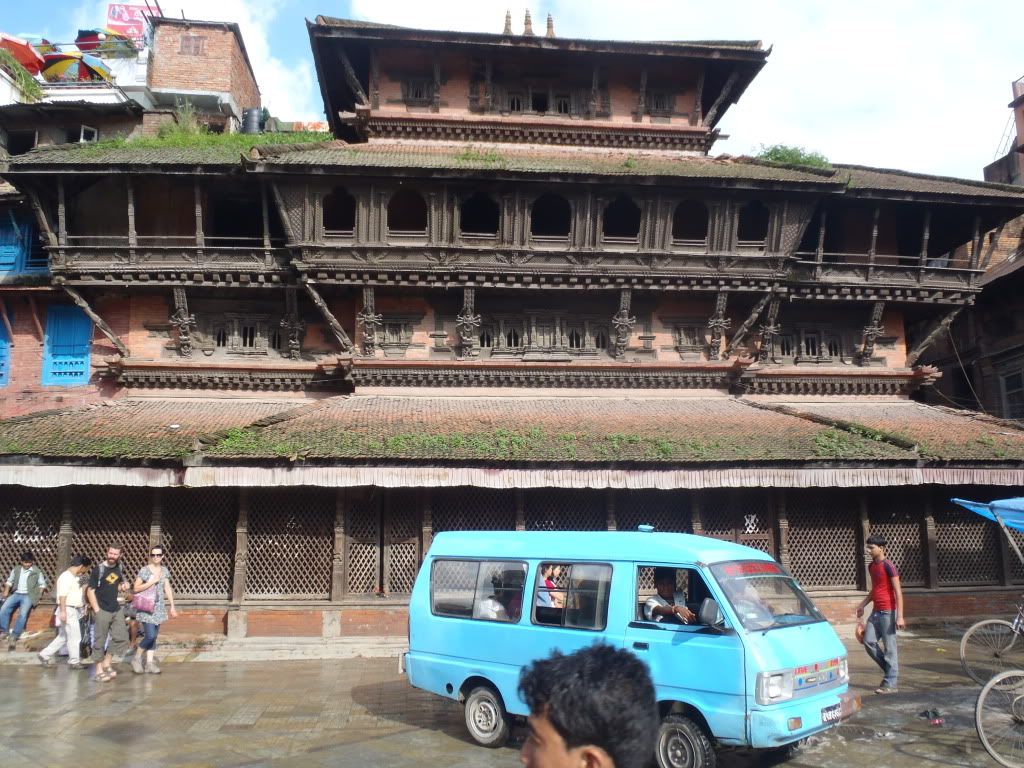
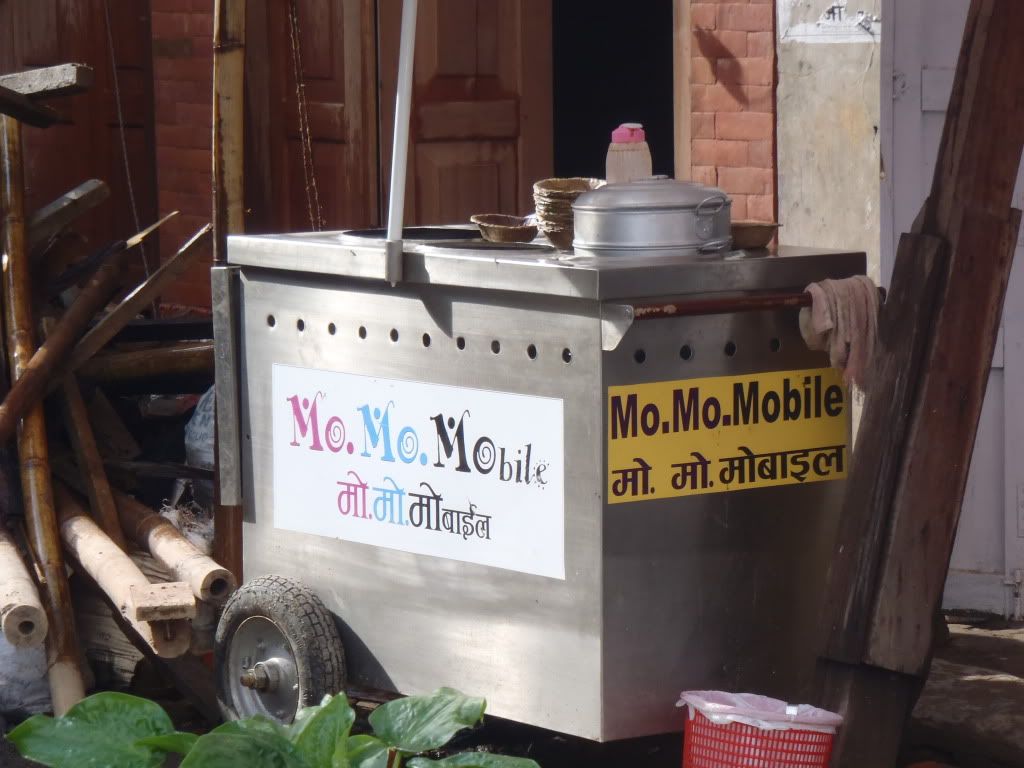
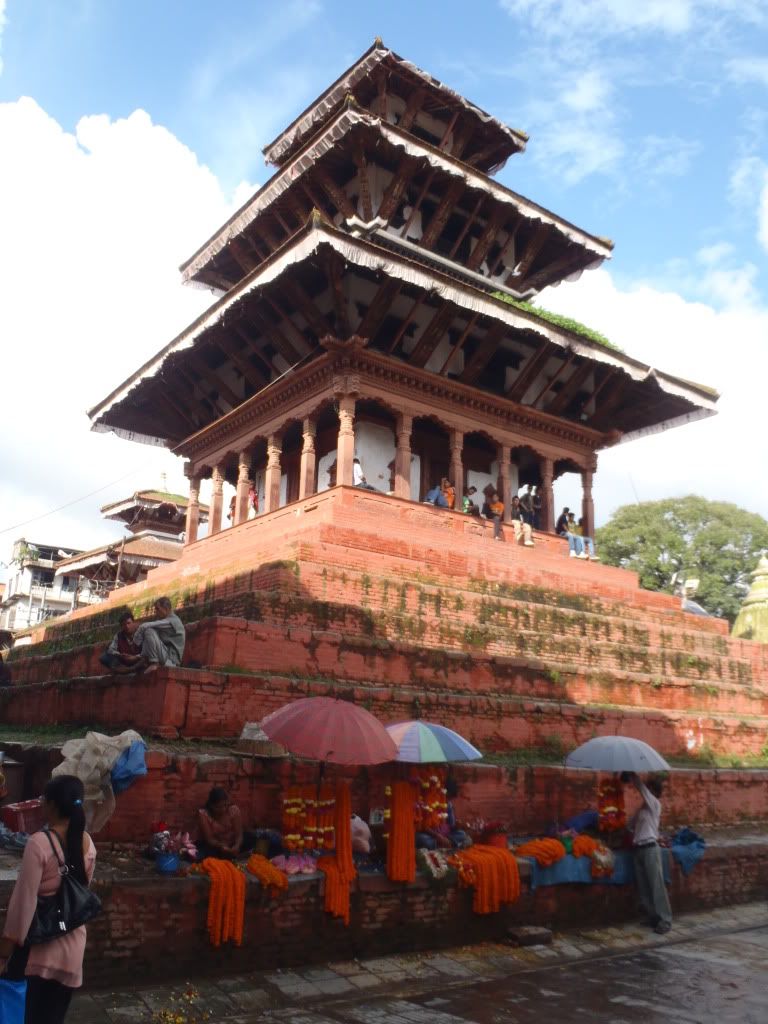
Before we left the square, we got our picture taken with one of the orange-clad men walking around. These men are Hindu sadhu (aka a mystic or wandering monk) and they wander around seeking liberation from the ‘cycle of life and dead’ through a life of meditation and asceticism. I found out from a Religionfacts.com that there are many different types of sadhus, some devoted more to one divine incarnation than others – such as Shaiva sadhus or Vaishnava sadhus, devoted to Shiva and Vishnu respectively. Sadhus are men (or women as well) known for their extreme devotional behavior such as deciding to remain silent or on one leg for many years at a time-- they often also become hermits. We wondered about the legitimacy of some of Durbar Square’s sadhus in their shedding of material wants; we were followed many times by men eager to have their picture taken with us for a quick ‘donation’ on our part. But they looked pretty cool, so it was worth it regardless of their sincerity. Anyone disagree?

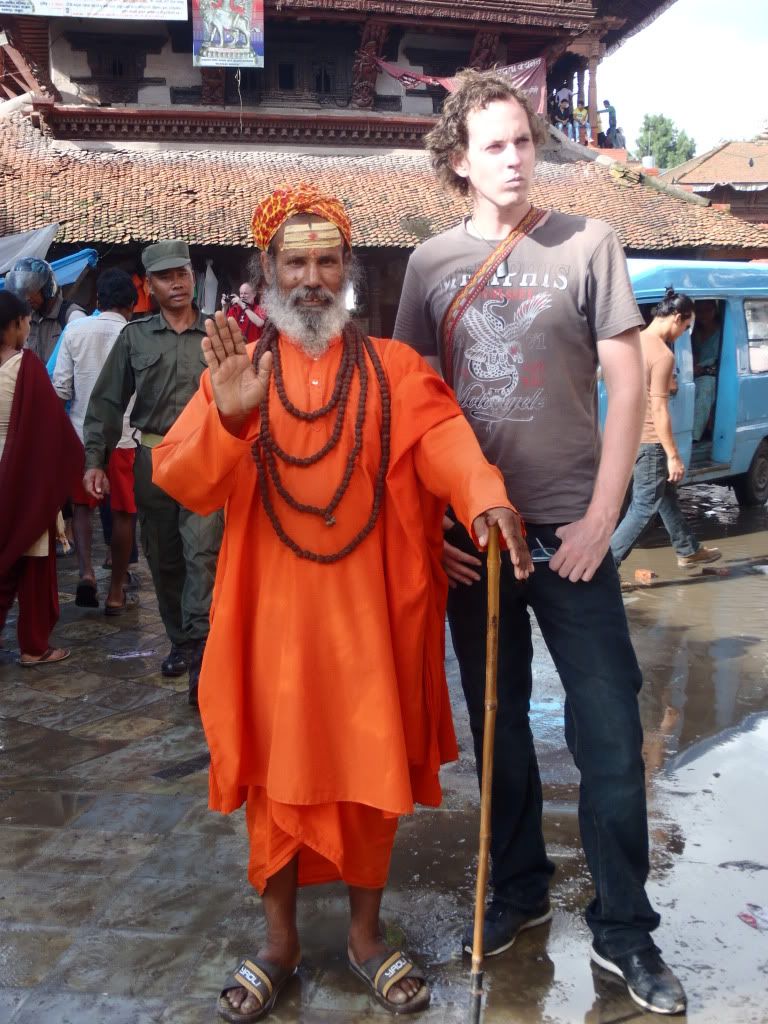
Henk and I ended the day with a trip to La Dolce Vita for what is HANDS DOWN the BEST Italian food in Kathmandu. Possibly some of the best I’ve ever eaten! (And I AM half Italian…) What a shock to find not just decent but delicious Italian food in the capital of Nepal. Highly recommended! We dined at the restaurant on one chicken parmigiana with a tossed salad, one penne pomodoro with garlic bread, and a yummy appetizer of cheese focaccia that resembled a mini, herbed pizza without sauce. Then it was back to the hostel for sleep!
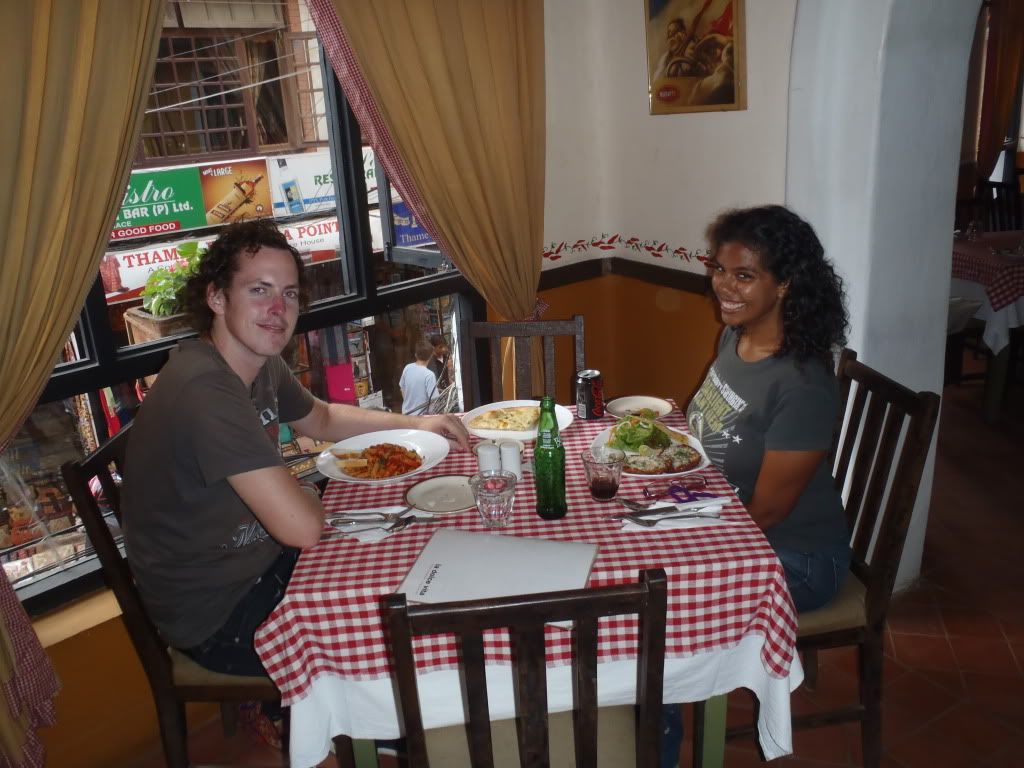
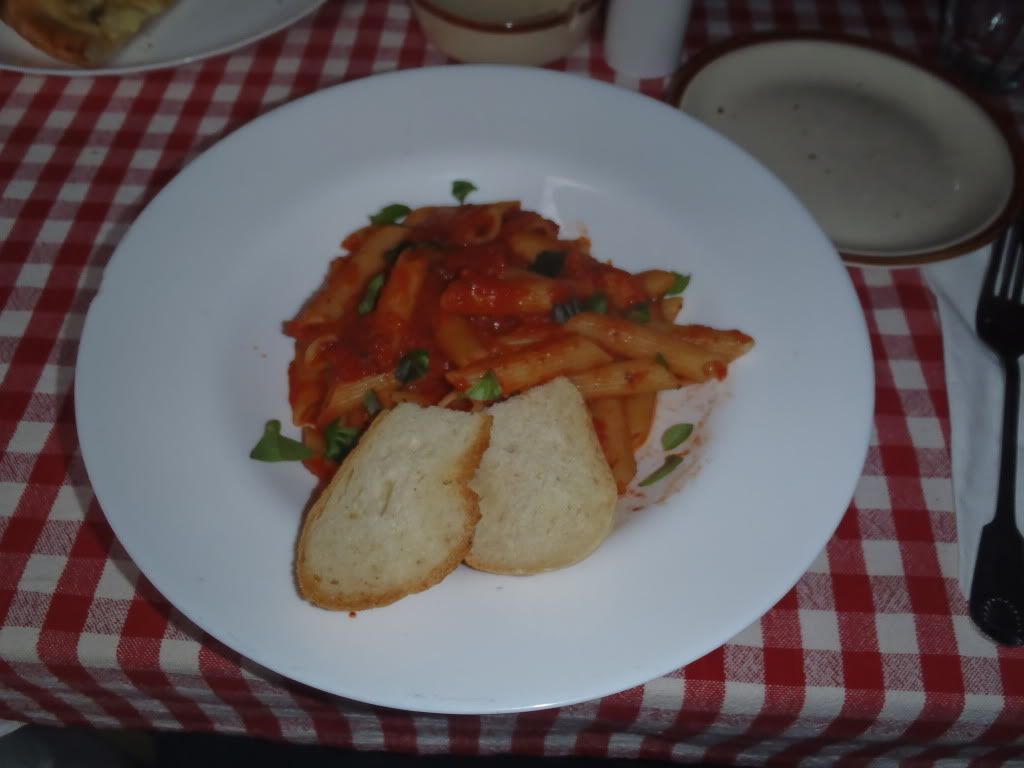
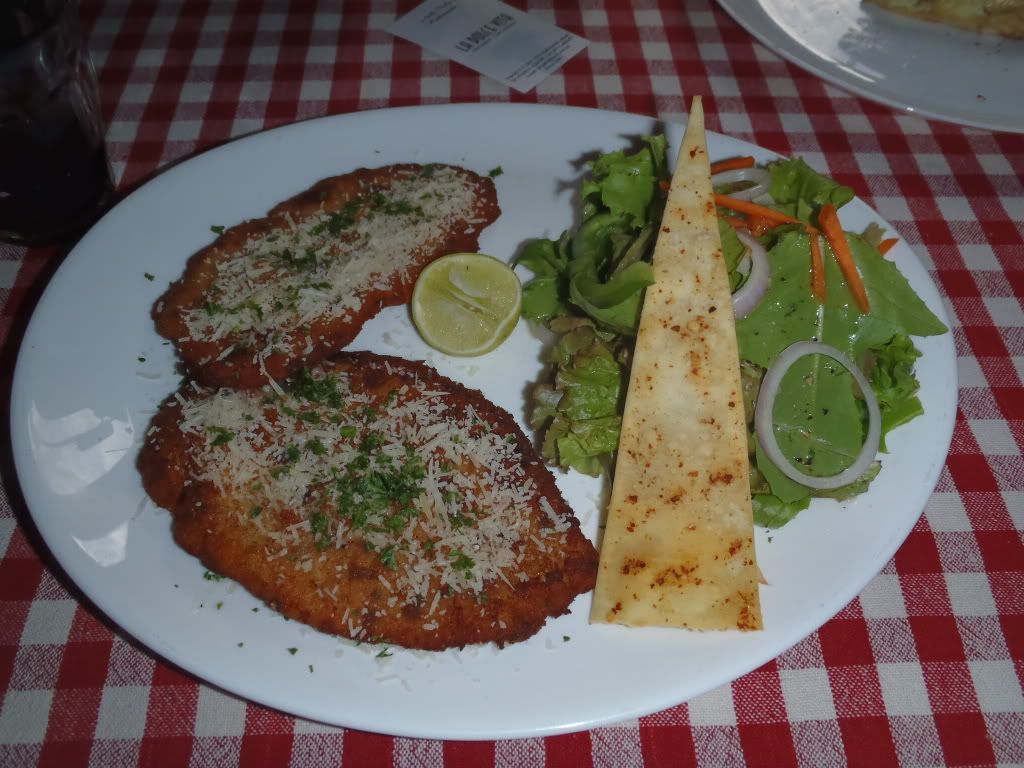
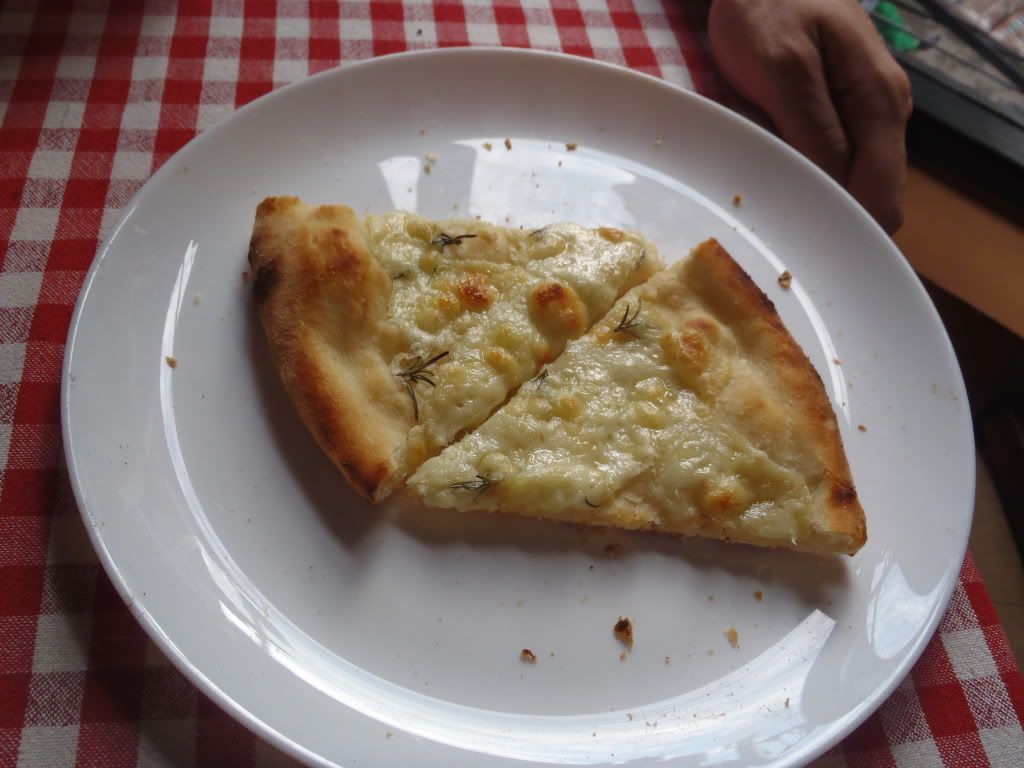
Until next time,
Francesca
Durbar Square wasn’t the easiest to walk around in… unlike the other Durbar squares in Bhaktapur and Patan, Kathmandu’s Durbar had traffic running through the center. It was a bit annoying to explore the square while dodging cars and rickshaws constantly… plus there were pigeons everywhere! Rats with wings! Since it was almost 12:30 PM we headed to the places that would close first – the Hanuman Dhoka Palace and a few interesting museums located within the palace grounds (which we found out were there after entering.) We entered through the palace gates, passing a 17th century statue of Hanuman, along with a few other Hindu deities. There was row after row of white rooms, lightly accented by rows of color along the windows or balcony. The multiple buildings stood in a box or rectangle shape to form a space in the middle which served as the main courtyard or Nasal Chowk. There was also a Hanuman Temple in the courtyard that had five ‘saucer’ or ‘circular’ rings forming its roof.







The Hanuman Dhoka is the former home of the Malla Kings – Nepal, previous to the Maoist government takeover, was a monarchy with royals ruling over the people. In fact it was H.M. King Tribhuvan Memorial Museum we entered first, a museum which paid tribute to the past and most recent royal rulers. The museum was filled with the royals’ personal belongings including their thrones, furniture, weapons, collections, etc. We walked through the museum and saw all of the King’s childhood effects and photos of him as a youngster. In fact, there were many photos of the King’s entire life – meeting with other royals, going on trips to various countries, hunting expeditions. We weren’t allowed to take any photos ourselves, so you’ll have to rely on words to get the gist of it. Here is some great information I found from Nepal’s tourism website about the King’s life, support of democracy, and the process of Nepal’s transition to democracy:
“The King of Nepal, King Tribhuvan, was born in Kathmandu on 30 June 1906. His mother was the regent, as he became king at the tender age of 5. Tribhuvan was officially crowned in the year 1913, but the Royal Family did not rule Nepal. The Rana family was in control of the country and they often made decisions that had a negative impact of the country. It is known that during World War I, the Rana prime minister literally held a gun to the head of King Tribhuvan’s mother in an effort to force him into supporting their war efforts. Blackmail was the only method the Rana’s could use to have the King agree to their requests.
Fortunately the public became increasingly unhappy with the Rana’s rule and they supported the return of the country’s power to the monarch. By the 1930’s the King was of age to rule Nepal. It was only due to the outbreak of World War II that the Rana’s spared the kings’ life. They did this on the request of the British who wanted Nepal backing them in the war. But after the war ended and Britain moved out of India, the King and his family fled to India to escape the wrath of the disposed Rana family. Through pressure from the public and from international countries, the Rana’s were forced to admit defeat and conform to the kings’ dream of democracy. King Tribhuvan took charge of the country’s transition until his untimely death due to illness in 1955.”
One of the most interesting (and tragic) stories we heard in the museum about Nepalese royals occurred very recently, in 2001. Dipendra Shah, son of the then-current King of Nepal grew extremely angry at his mother for denying him the right to marry his girlfriend, a Rana girl. Traditionally the Shah had been intermarrying with the Rana clan but the two families never had any love for one another and his mother didn’t want him to marry a Rana girl. One night, Dipendra got drunk and went on a rampage, massacring his entire family – father, mother, brother, sister – before killing himself as well.
Once we went outside the palace, we spotted the Jagganath Temple, probably built by King Malla, and definitely one of the oldest buildings in Durbar Square. The temple is famous for its wooden erotic roof carvings. Basically, nothing is left to the imagination! Equivalent of ancient-times ‘soft porn,’ these carvings helped locals figure out what to do sexually with others serving as a ‘how to’ guide of sorts. When we walked further to the right, Henk and I spotted the infamous stone inscription we had read about previously. The story goes that if someone deciphers all of the different 15 languages on the inscribed wall, milk should flow from the spout in the center. Since Henk has an interest in languages, I wanted him to try and decipher the code but there were quite a few ancient/archaic ones on there that even locals would have no idea about! We later heard that there are 53 different languages in Nepal alone, and that's not including those language mixes that have gone ‘out of style’ over the years. Some languages only have a few people left who can decipher them, which is probably very dangerous for the preservation of Nepal’s heritage.





The next thing that caught our eyes was the white-roof (now slightly green-roofed due to mold and aging) on the Kakeshwar Temple – a temple with a bit of mixed architectural styles such as the Newari-style floor and the Indian-style upper storey. That must be why it looks a little out-of-place in the square! The Taleju Temple (built in 1564 by King Mahendra Malla) was next on our list, and it impressed us with its decorative gate with guarding lions out front. The various symbols, eyes and Hindu figures, reminded me of a secret organization in the way it is presented. The temple itself was built in honor of a goddess named Taleju Bhawani who became popularized as the goddess of the Malla Kings.





We couldn’t go into the temple itself, much less past the imposing gates, so we moved on to the opposite end of the square to peek at the Mahendreshwar (Shiva) Temple. One thing to notice about this temple is the long ‘ladder’ or ‘chain’ of what looks like gold-colored plates hanging together from the top of the temple leading to the bottom. While the exact purpose of these plates doesn’t seem to be 100% certain, I heard that they are there for the gods to use in case they need to come down to earth (say as an incarnation, etc.) to complete ‘divine business.’ This temple had one of the best examples of such ladders, so take a look! It started to rain quite hard at this point, so we ducked into the Tana Deval Temple which had skulls and seemingly hideous faces adoring its walls. The feeling of the creepy-yet-cartoony characters reminded me of Halloween!





Once the rain let up a little we walked down Makhan Tole which was supposed to be one of the more interesting streets to check out in Kathmandu. Perhaps it was due to the rain, but the street didn’t seem too special to us. We passed a few smaller temples before stopping in awe in front of the large, colorfully decorated carving of one of Shiva’s manifestations -- Kala (Black) Bhairab – who tramples a corpse representing human ignorance. This demonic-looking deity’s origin is best told in the following tale I read on a religions and gods blog:

“The origin of Bhairava can be traced to the conversation between Lord Bramha and Lord Vishnu recounted in "Shiv Maha-Purana" where Lord Vishnu asks Lord Bramha who is the supreme creator of the Universe. Arrogantly, Bramha tells Vishnu to worship him because he (Bramha) is the supreme creator. This angered Shiva who in reality is the creator of all. Shiva then incarnated in the form of Bhairava to punish Bramha. Bhairava beheaded one of Bramha's five heads and since then Bramha has only four heads. When depicted as Kala Bhairava, Bhairava is shown carrying the amputated head of Brahma. Cutting off Brahma's fifth head made him guilty of Brahmanicide, and as a result, he was forced to carry around the head for years until he had been absolved of the sin.”



Next we found an old Shiva-Paravati Temple with a special twist. If you look at the top window, you can see the figures of Shiva and Paravati looking out at the square below. Not much to say about this one, just interesting to look at it! After passing an effortless yet striking statue of the half-man/half-bird Garuda, we finally found it. Was was it?






IT was one of the most fascinating buildings: the home of the living goddess Kumari. The Kumari Bahal was built in 1757 and has three stories with carved wooden windows and a courtyard in the center. Henk and I explored the courtyard of the Kumari’s house, knowing that we would see her later that month at the Indra Jatra festival. The building is still used to house her and her caretakers, visitors can enter the courtyard but the Kumari is only allowed to go into public during the Indra Jatra festival or other ceremonies. The living goddess is only worshipped as a living version of the divine Taleju (the goddess of creative feminine force) from the time she is chosen until she has her first period (or loses a lot of blood some other way) and ‘becomes mortal’ again as Taleju leaves her body. From the Wiki page on the Kumari, I learned the origin of the living goddess:


“There are several legends telling of how the current tradition of the Kumari began. Most of the legends, however, tell of King Jayaprakash Malla, the last Nepalese king of the Malla Dynasty (12th-17th century CE). According to the most popular legend, a red serpent approached the king's chambers late one night as he played tripasa, a dice game, with the goddess Taleju. The goddess came along every night to play the game, with the condition that the king refrain from telling anyone about their meetings.
But one night the king's wife followed him to his chamber in order to find out who the king was meeting so often. The king's wife saw Taleju and the goddess was angered. She told the king that, if he wants to see her again or have her protect his country, he'd have to search for her among the Newari (Shakya) community, as she would be incarnated as a little girl among them. Hoping to make amends with his patroness, King Jayaprakash Malla left the palace in search of the young girl who was possessed by Taleju's spirit.”
Once a potential Kumari is found, she is tested is various ways. Since the Kumari is the living Taleju, she is supposed to be fearless. This is tested by bringing placing potentials in front of bloody animal heads to see if they get scared – even having the children spent a night in a room filled with animal heads. (The real Kumari would obviously show no fear.) The Kumari’s looks must be feminine and ‘dainty’ and she must have black eyes and hair. A few of the other psychical requirements (via Wiki) are:
• A neck like a conch shell
• A body like a banyan tree
• Eyelashes like a cow
• Thighs like a deer
• Chest like a lion
• Voice soft and clear as a duck's
Finally, the Kumari must pick out the possessions of the former Kumari, much like the potential Lamas must do in the search for the new Dalai Lama. Once all of these tests are completed, there is one little girl left who becomes the Kumari and moves into the Kumari Bahal. By now it was just past 3:00 PM and we were getting hungry for something to snack on. A quick look through our Lonely Planet had us heading towards ‘Freak Street’ – a street near Durbar Square that used to be known for its, well, freaks. It was here that we found Snowman Cafe, a cake shop with amazingly delicious cakes. We opted for two slices, one chocolate and one apple. While the eatery looked really sketchy at first, the cake did impress and we left with full stomachs.


Returning to Durbar Square, we did a couple more hours of sightseeing. Since we have already discussed the bulk of Durbar Square, I’ll just summarize the last few buildings we saw: Kasthamandap is a large, three-roofed wooden building with decorative windows that was once a community center, but now is the remainder of a temple dedicated to the ascetic Goraknath. We saw a meeting of some kind going on inside while we were there, but it didn’t look very religious in nature, so maybe the building is a community center again. Next we saw a small Shikara-style (or Indian-style) stupa, and later the Trailokya Mohan Narayan Temple which was built in 1680 and dedicated to Vishnu.




Before we left the square, we got our picture taken with one of the orange-clad men walking around. These men are Hindu sadhu (aka a mystic or wandering monk) and they wander around seeking liberation from the ‘cycle of life and dead’ through a life of meditation and asceticism. I found out from a Religionfacts.com that there are many different types of sadhus, some devoted more to one divine incarnation than others – such as Shaiva sadhus or Vaishnava sadhus, devoted to Shiva and Vishnu respectively. Sadhus are men (or women as well) known for their extreme devotional behavior such as deciding to remain silent or on one leg for many years at a time-- they often also become hermits. We wondered about the legitimacy of some of Durbar Square’s sadhus in their shedding of material wants; we were followed many times by men eager to have their picture taken with us for a quick ‘donation’ on our part. But they looked pretty cool, so it was worth it regardless of their sincerity. Anyone disagree?


Henk and I ended the day with a trip to La Dolce Vita for what is HANDS DOWN the BEST Italian food in Kathmandu. Possibly some of the best I’ve ever eaten! (And I AM half Italian…) What a shock to find not just decent but delicious Italian food in the capital of Nepal. Highly recommended! We dined at the restaurant on one chicken parmigiana with a tossed salad, one penne pomodoro with garlic bread, and a yummy appetizer of cheese focaccia that resembled a mini, herbed pizza without sauce. Then it was back to the hostel for sleep!




Until next time,
Francesca

0 Comments:
Post a Comment
<< Home